I think the molasses would be too flavorful a light LME would be better. The diastatic powder is meant to convert some starch to sugar… I know many bread recipes have a touch of sugar or more if it is meant to be a sweet bread. Typically bagels aren’t noticeably sweet so this is for the yeast apparently. I’ve made bagels without the malt powder and they were fine in flavor and texture.Thanks @Hoppy2bmerry . I think the diastatic powder is, as you say, a sweetener and maybe something to assist the yeast in fermentation. The liquid syrup in the recipe is to "add color to the finished bagels". Since I can't get the product they recommend I'm wondering if I could just use molasses, or LME and get the same results. Would either of those substitutes effect flavor?
You are using an out of date browser. It may not display this or other websites correctly.
You should upgrade or use an alternative browser.
You should upgrade or use an alternative browser.
Homemade Bread Thread
- Thread starter deadfall
- Start date

Help Support Homebrew Talk:
This site may earn a commission from merchant affiliate
links, including eBay, Amazon, and others.
There was a discussion regarding diastatic malt powder in the pizza thread, I believe there was talk about using ground malted barley instead of the pre-packaged stuff.
The Home Made Pizza Thread
The Home Made Pizza Thread
Coastalbrew
Well-Known Member
- Joined
- Oct 26, 2018
- Messages
- 1,053
- Reaction score
- 824
Thanks, I'll read through that thread and see what I can find out there.There was a discussion regarding diastatic malt powder in the pizza thread, I believe there was talk about using ground malted barley instead of the pre-packaged stuff.
The Home Made Pizza Thread
Cheers!

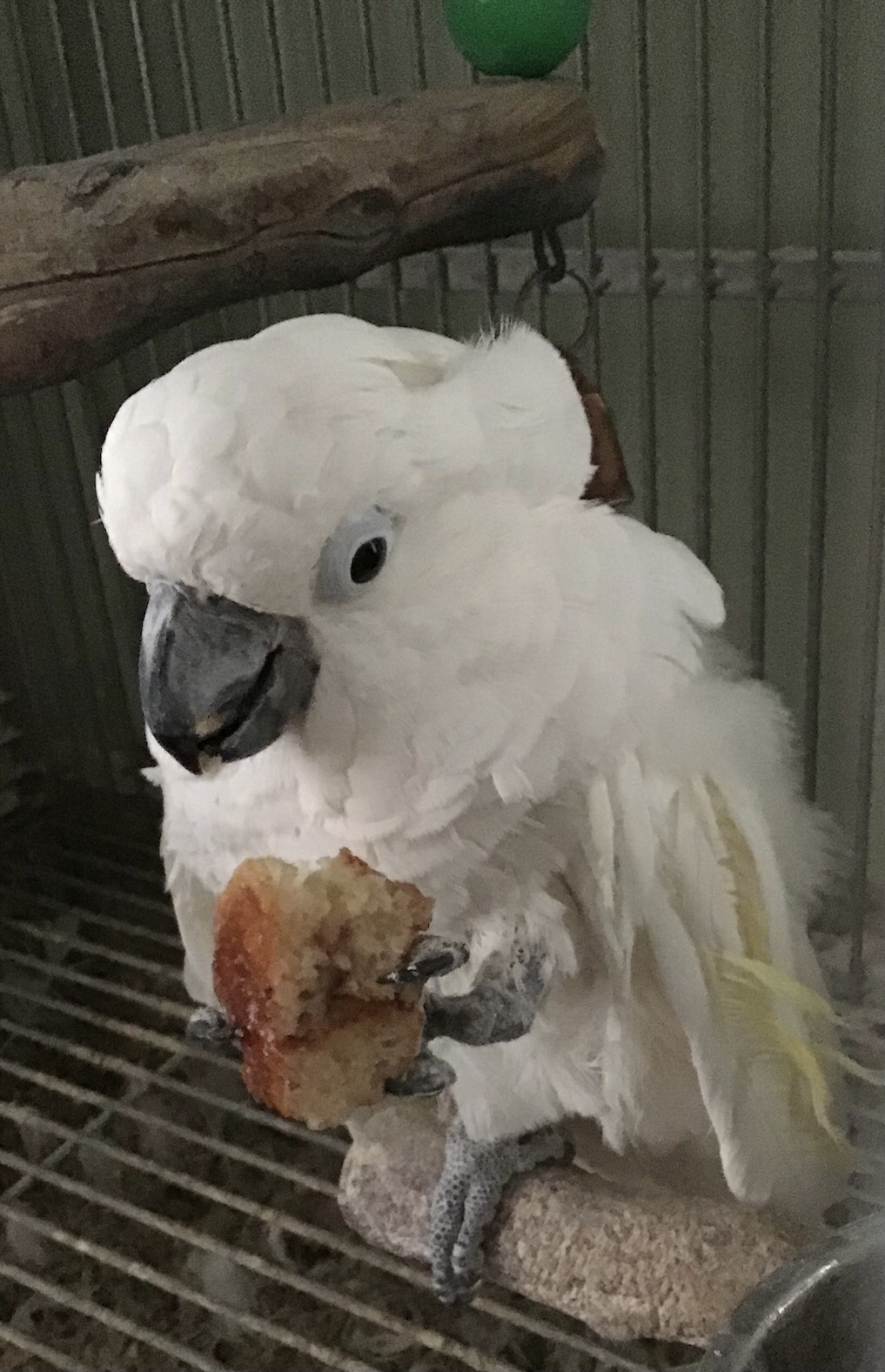

Cinnamon rolls (enjoyed by all the family) and dinner rolls. Happy New Year to everyone!
Hogie rolls.
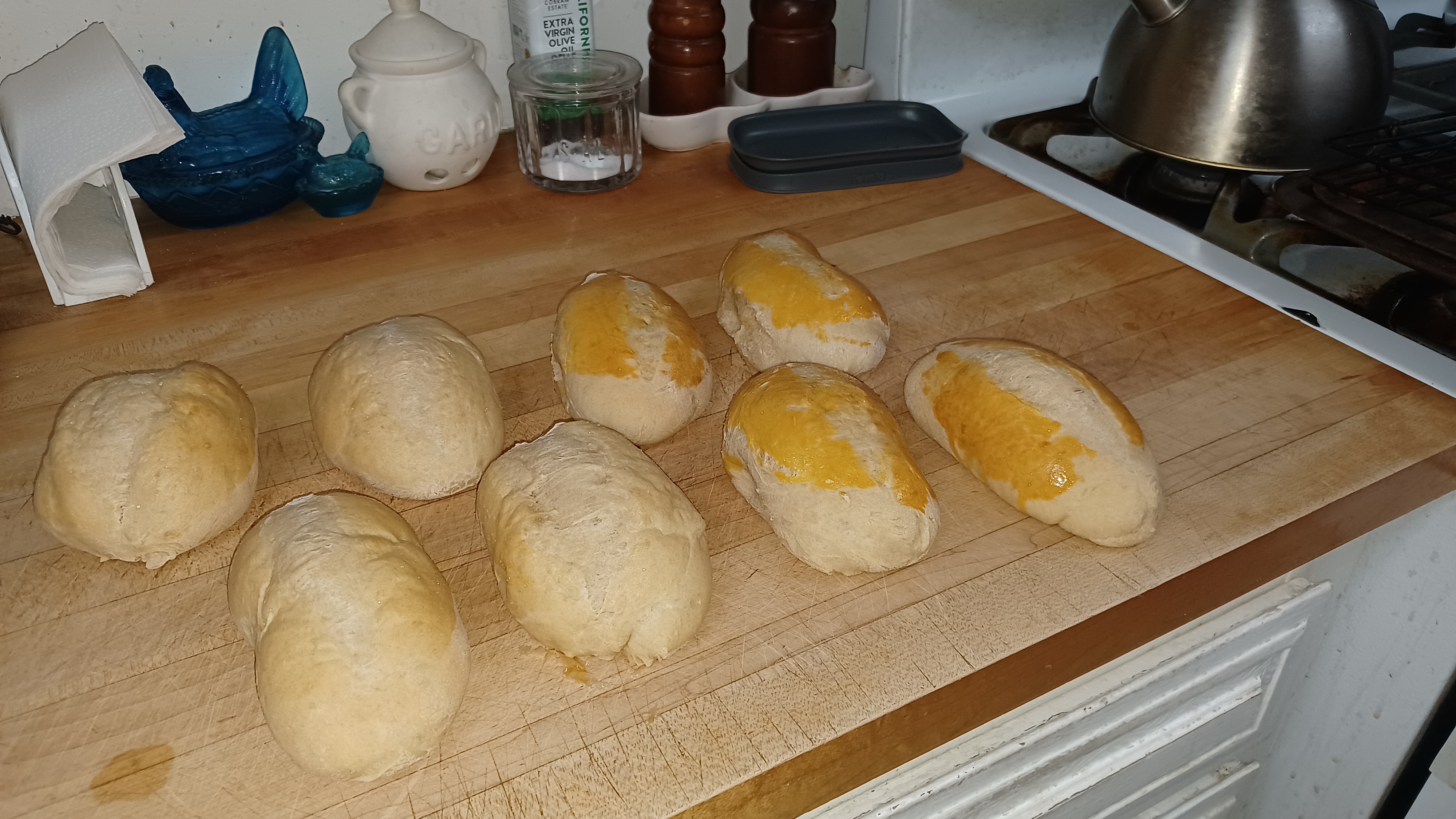
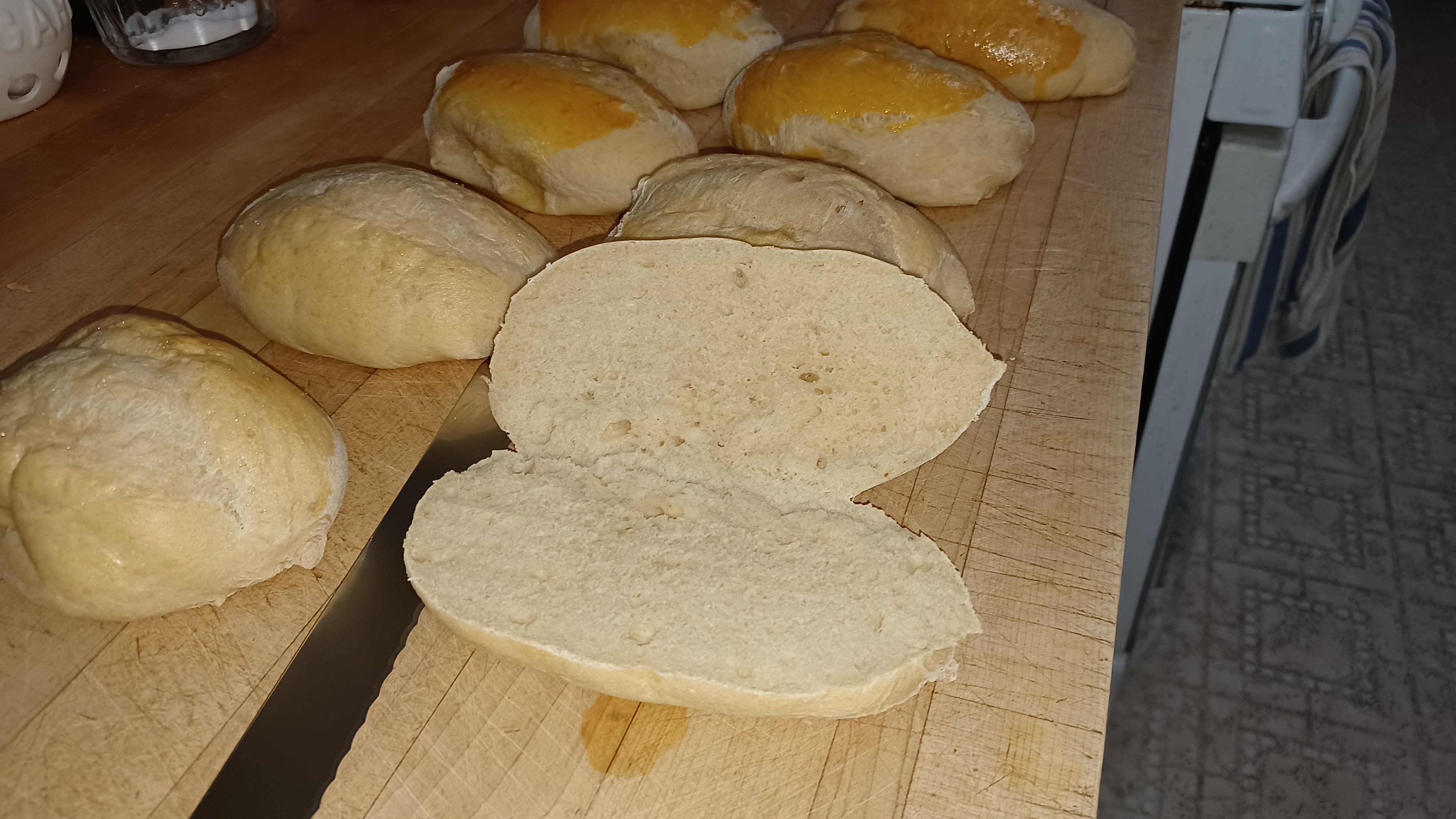


- Joined
- Mar 12, 2021
- Messages
- 199
- Reaction score
- 590
My daughter bought this appropriate apron for Xmas. Holding a glass of my Russian Imperial Stout.



$10.99 ($31.16 / Ounce)
Hornindal Kveik Yeast for Homebrewing - Mead, Cider, Wine, Beer - 10g Packet - Saccharomyces Cerevisiae - Sold by Shadowhive.com
Shadowhive

$7.79 ($7.79 / Count)
Craft A Brew - LalBrew Voss™ - Kveik Ale Yeast - For Craft Lagers - Ingredients for Home Brewing - Beer Making Supplies - (1 Pack)
Craft a Brew

$53.24
1pc Hose Barb/MFL 1.5" Tri Clamp to Ball Lock Post Liquid Gas Homebrew Kegging Fermentation Parts Brewer Hardware SUS304(Liquid Hose Barb)
Guangshui Weilu You Trading Co., Ltd

$53.24
1pc Hose Barb/MFL 1.5" Tri Clamp to Ball Lock Post Liquid Gas Homebrew Kegging Fermentation Parts Brewer Hardware SUS304(Liquid Hose Barb)
yunchengshiyanhuqucuichendianzishangwuyouxiangongsi

$20.94
$29.99
The Brew Your Own Big Book of Clone Recipes: Featuring 300 Homebrew Recipes from Your Favorite Breweries
Amazon.com

$33.99 ($17.00 / Count)
$41.99 ($21.00 / Count)
2 Pack 1 Gallon Large Fermentation Jars with 3 Airlocks and 2 SCREW Lids(100% Airtight Heavy Duty Lid w Silicone) - Wide Mouth Glass Jars w Scale Mark - Pickle Jars for Sauerkraut, Sourdough Starter
Qianfenie Direct

$44.99
$49.95
Craft A Brew - Mead Making Kit – Reusable Make Your Own Mead Kit – Yields 1 Gallon of Mead
Craft a Brew
![Craft A Brew - Safale S-04 Dry Yeast - Fermentis - English Ale Dry Yeast - For English and American Ales and Hard Apple Ciders - Ingredients for Home Brewing - Beer Making Supplies - [1 Pack]](https://m.media-amazon.com/images/I/41fVGNh6JfL._SL500_.jpg)
$6.95 ($17.38 / Ounce)
$7.47 ($18.68 / Ounce)
Craft A Brew - Safale S-04 Dry Yeast - Fermentis - English Ale Dry Yeast - For English and American Ales and Hard Apple Ciders - Ingredients for Home Brewing - Beer Making Supplies - [1 Pack]
Hobby Homebrew

$22.00 ($623.23 / Ounce)
AMZLMPKNTW Ball Lock Sample Faucet 30cm Reinforced Silicone Hose Secondary Fermentation Homebrew Kegging joyful
无为中南商贸有限公司

$176.97
1pc Commercial Keg Manifold 2" Tri Clamp,Ball Lock Tapping Head,Pressure Gauge/Adjustable PRV for Kegging,Fermentation Control
hanhanbaihuoxiaoshoudian

$58.16
HUIZHUGS Brewing Equipment Keg Ball Lock Faucet 30cm Reinforced Silicone Hose Secondary Fermentation Homebrew Kegging Brewing Equipment
xiangshuizhenzhanglingfengshop
Just awesome!My daughter bought this appropriate apron for Xmas. Holding a glass of my Russian Imperial Stout.View attachment 755021
First time for Facaccia. A little over cooked but tastes amazing!
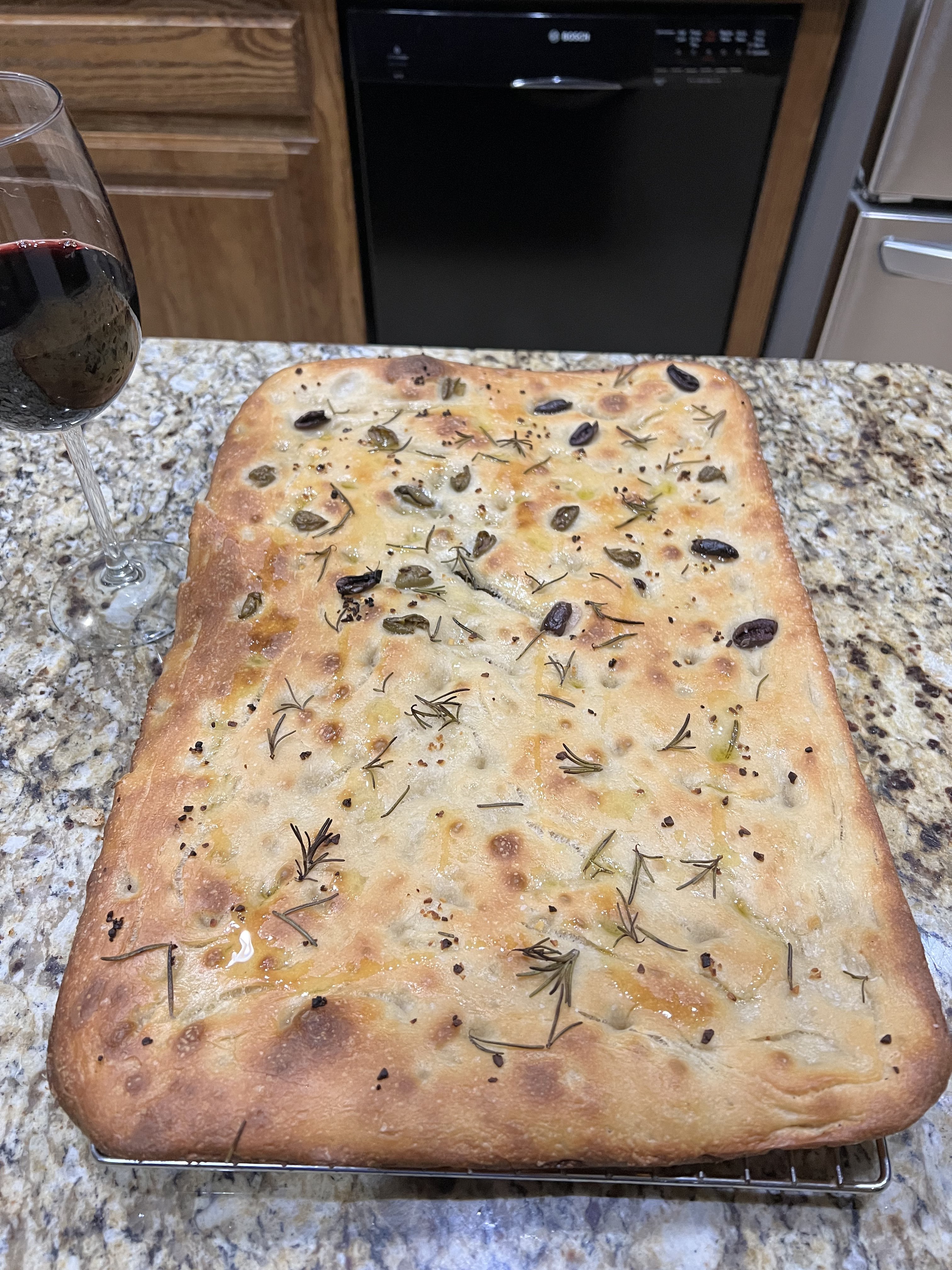

- Joined
- Mar 12, 2021
- Messages
- 199
- Reaction score
- 590
TandemTails
Well-Known Member
I've been doing some experiments with Diastatic Malted Barley Flour to see if it actually makes any difference with my bakes. The first test was with some Sourdough loaves but I wanted to try them in something that does typically call for it... Pretzels!
If you're not sure what diastatic malted barley flour is, it's basically extremely finely crushed barley, husk and all. It's supposed to provide a boost of nutrients for the bread yeast and give a darker color in baking.
To test it with the pretzels, I did two batches with the same ingredients, only one had 1 tsp of diastatic malted barley flour added to it (which is what seems to be the recommended amount for the amount of flour I was using).
Honestly, there was zero difference visually between the two batches. They both browned the same, had a similar crumb structure, rose the same amount and browned on the bottom similarly. The main difference is the batch with the barley flour had a lot more "pretzel" flavor. I didn't notice the lack of pretzel flavor when trying the batch without the barley flour, but as soon as I tried the one with the barley flour, it was really apparent.
The ingredients for each batch were:
* 3 3/4 cups (~560g) bread flour
* 1/4 oz (about 2 tsp) instant yeast
* 2 tsp sea salt
* 1 1/4 cups (~315mL) water (110’F)
* 3 Tbsp unsalted butter, melted
* 1 tsp Diastatic Malted Barley Flour (for one batch)
* Pretzel or coarse sea salt for topping (optional)
Pretzel bath (I doubled the amount below so I could use a bigger pot):
* 4 1/4 cups water
* 3 Tbsp baking soda
Full method and instructions here: Diastatic Malted Barley Flour Experiment #2 – Pretzels
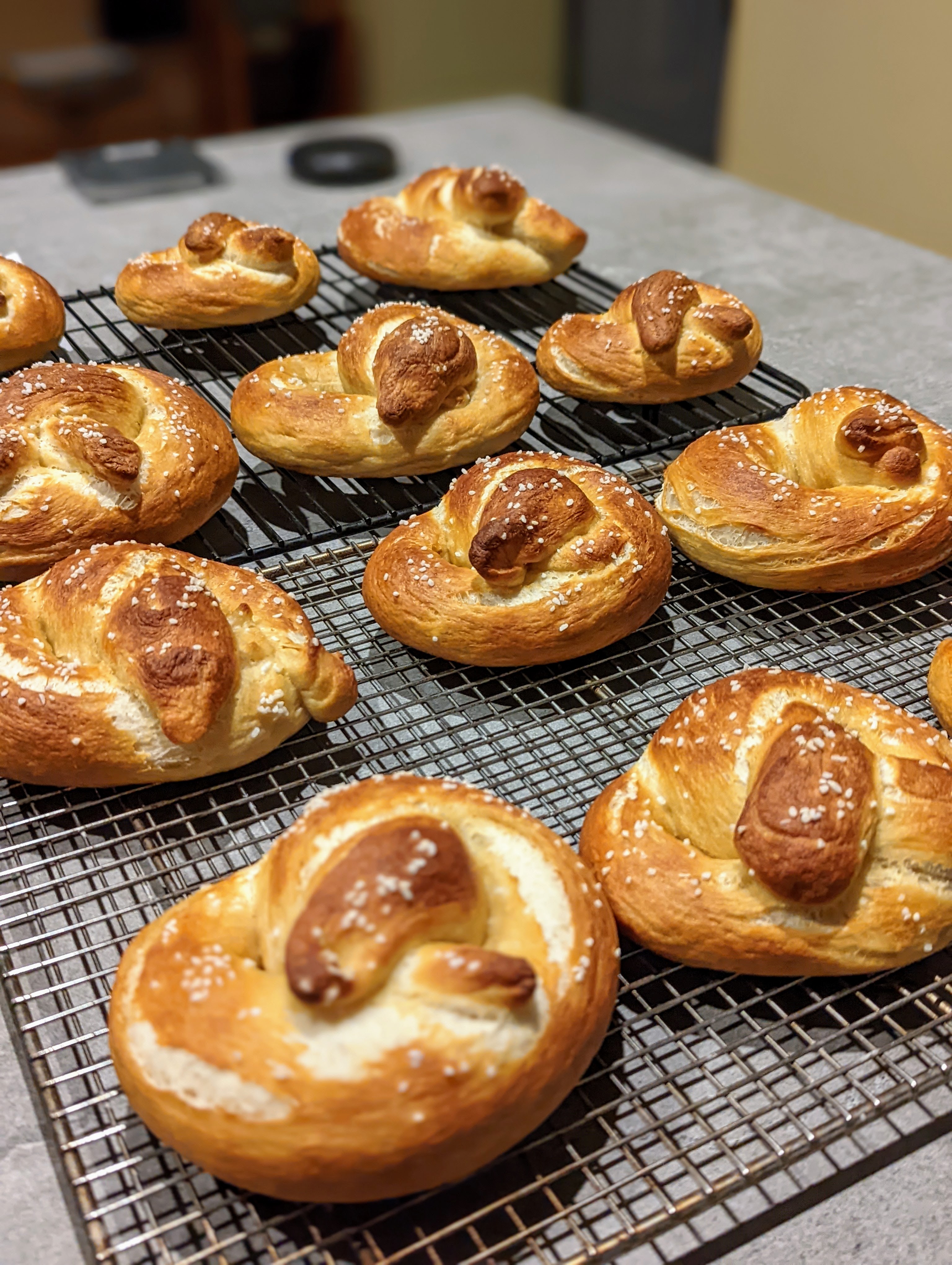
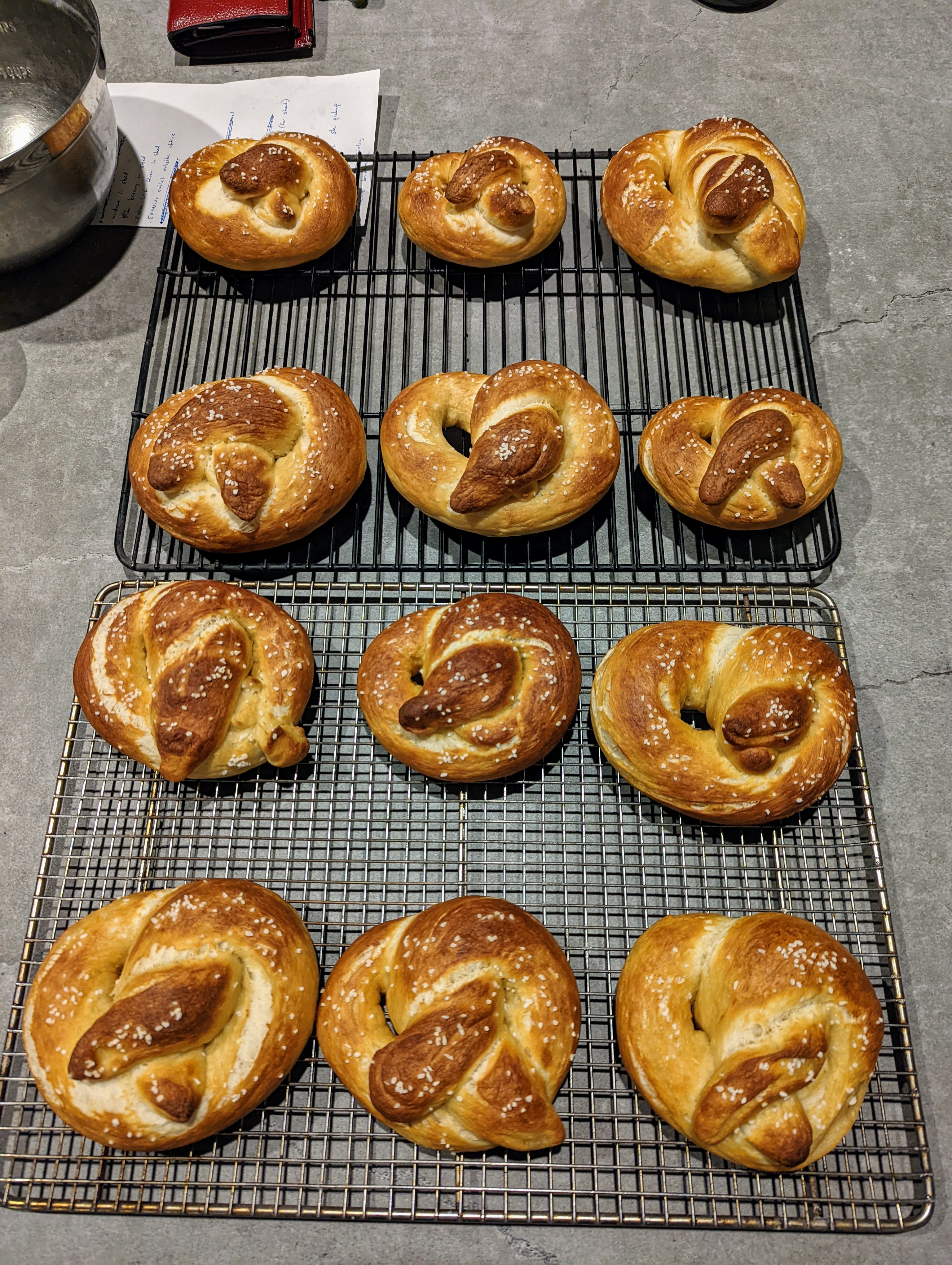
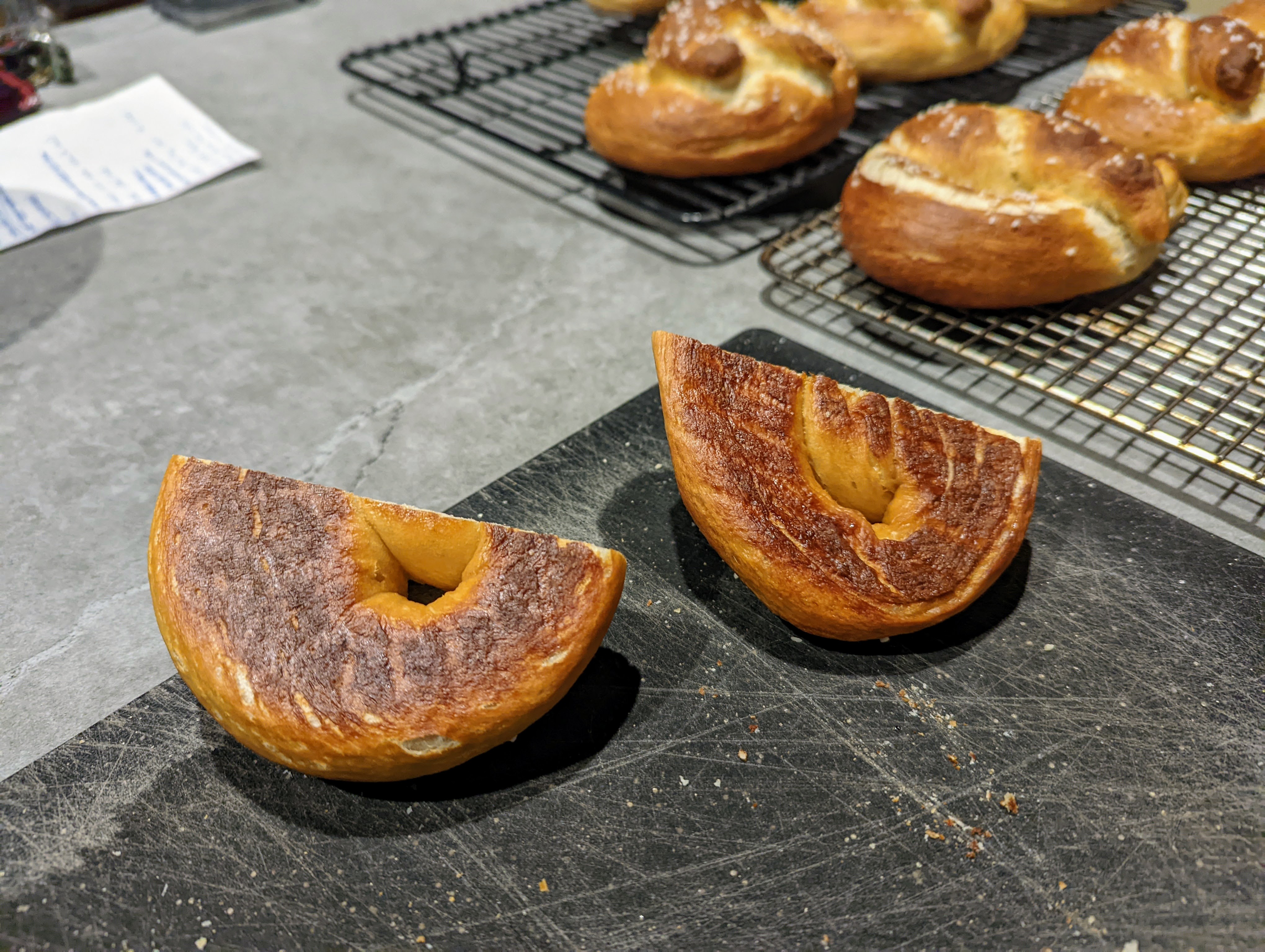
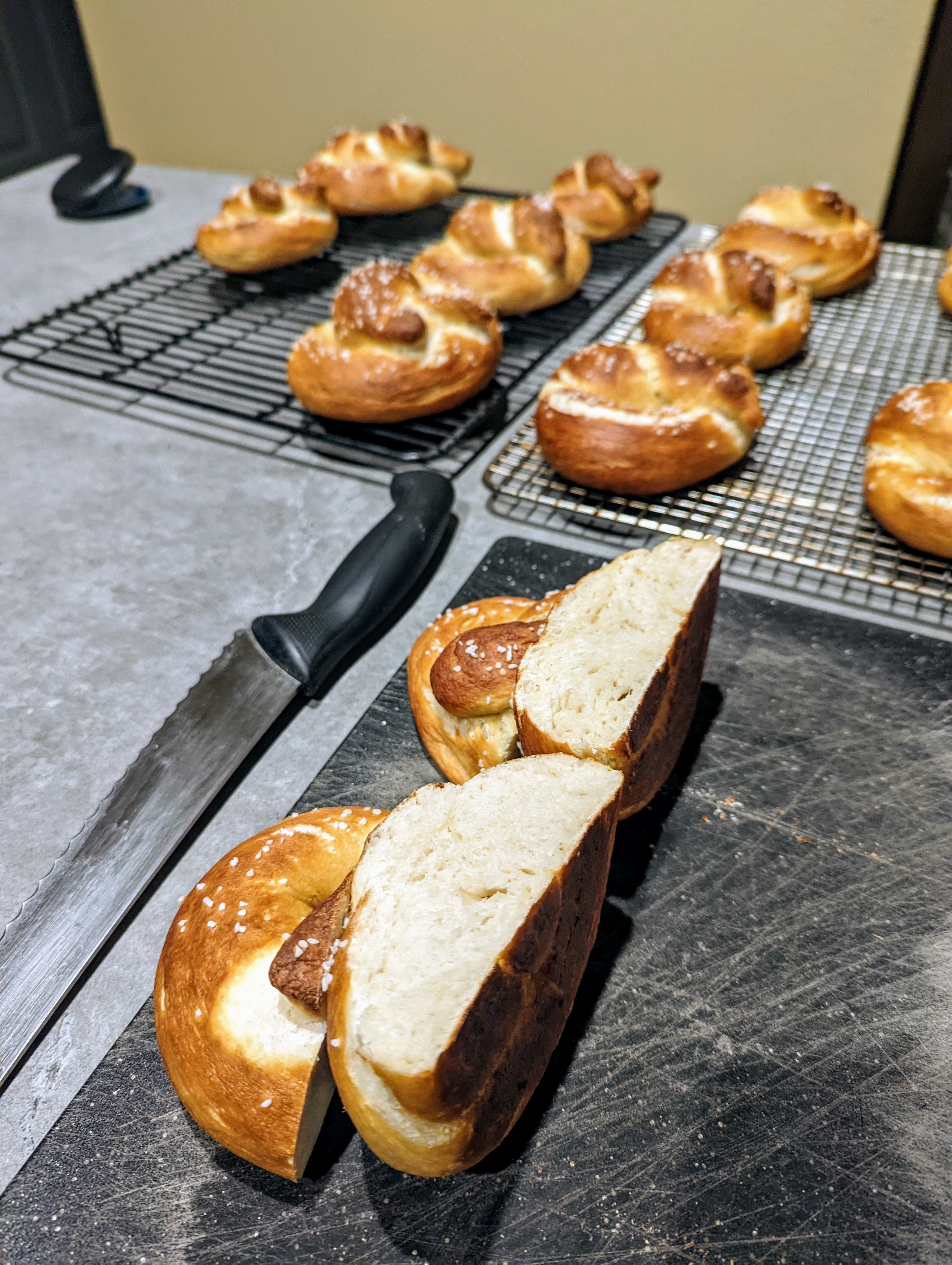
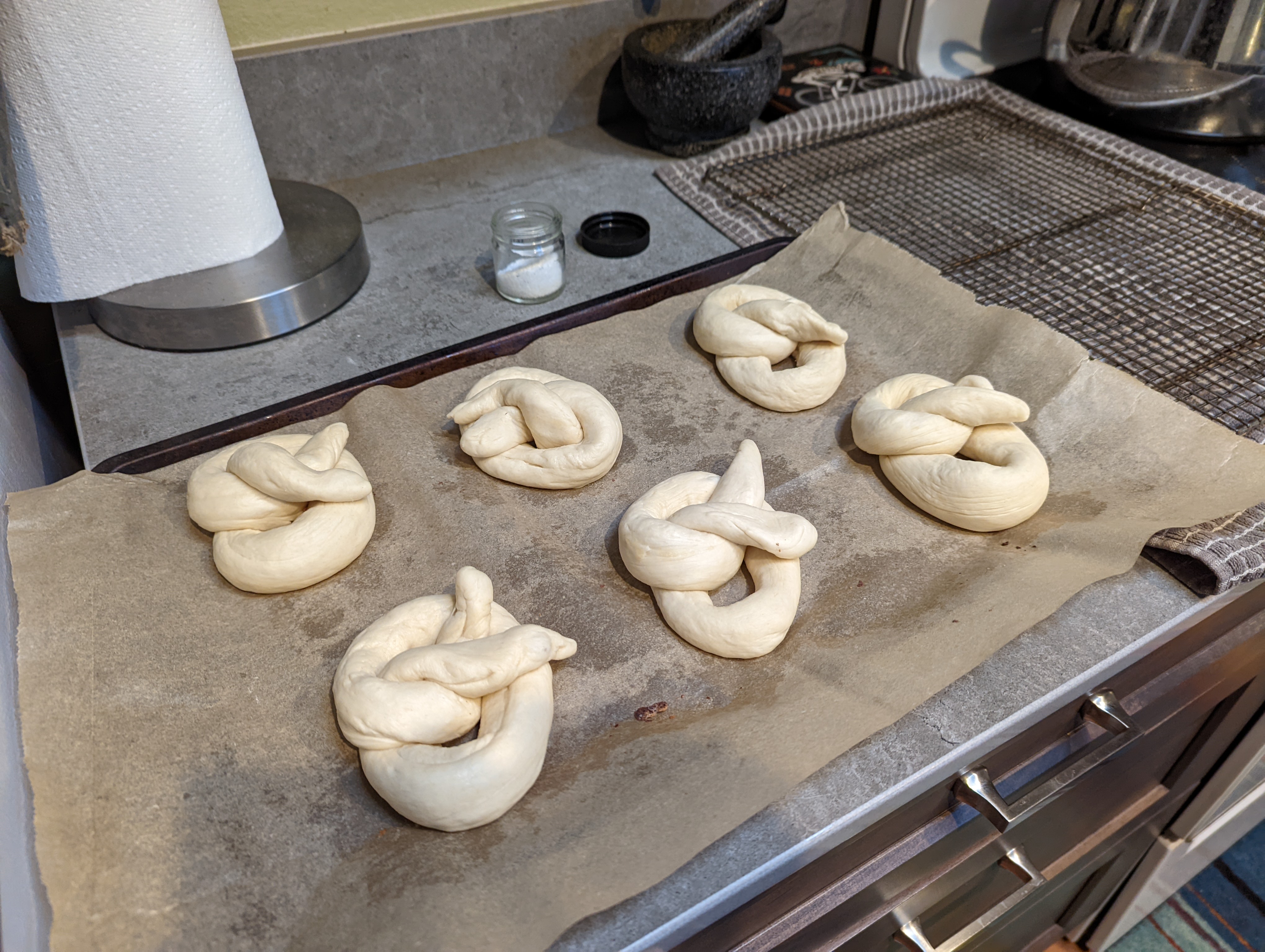
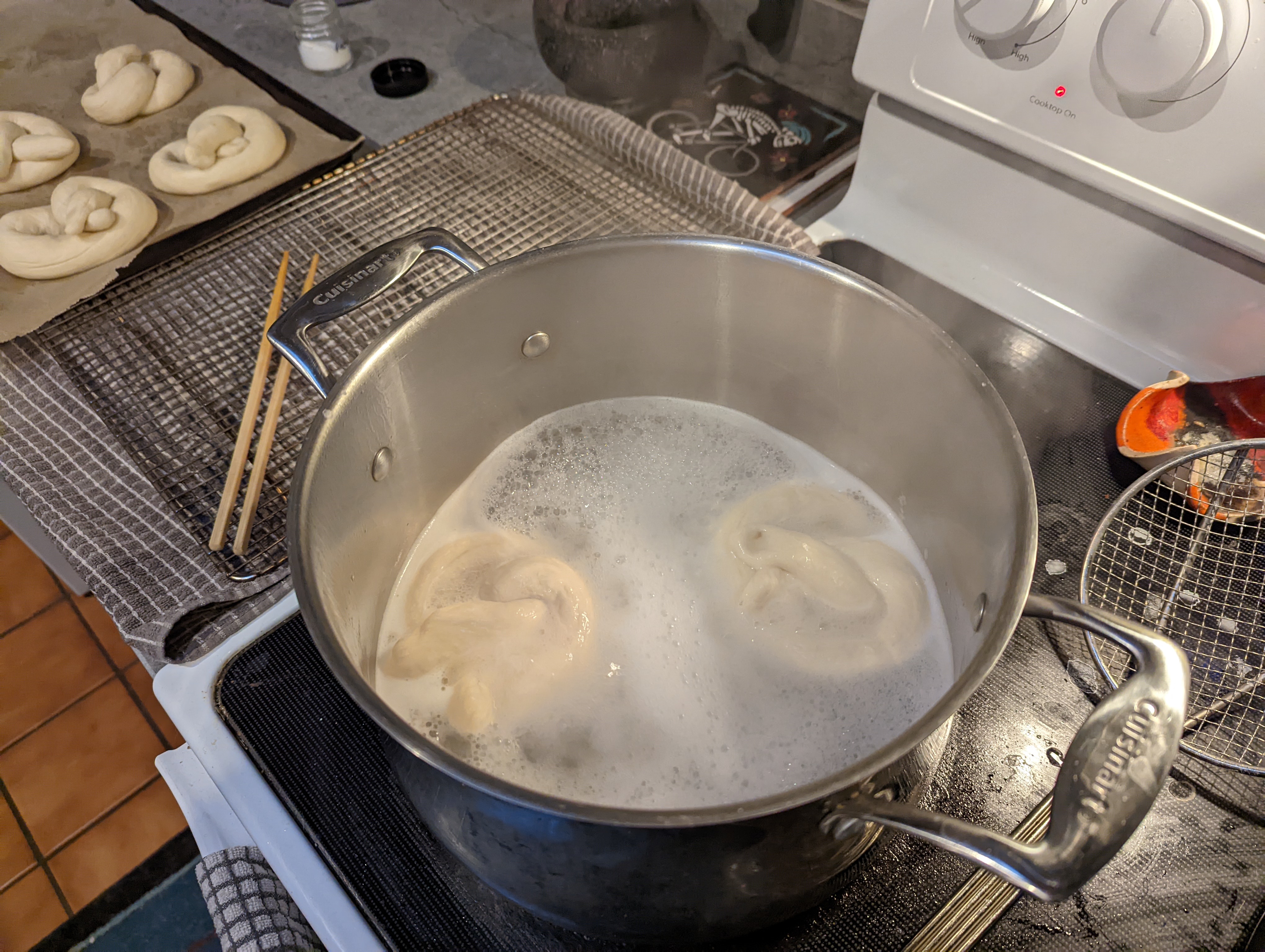
If you're not sure what diastatic malted barley flour is, it's basically extremely finely crushed barley, husk and all. It's supposed to provide a boost of nutrients for the bread yeast and give a darker color in baking.
To test it with the pretzels, I did two batches with the same ingredients, only one had 1 tsp of diastatic malted barley flour added to it (which is what seems to be the recommended amount for the amount of flour I was using).
Honestly, there was zero difference visually between the two batches. They both browned the same, had a similar crumb structure, rose the same amount and browned on the bottom similarly. The main difference is the batch with the barley flour had a lot more "pretzel" flavor. I didn't notice the lack of pretzel flavor when trying the batch without the barley flour, but as soon as I tried the one with the barley flour, it was really apparent.
The ingredients for each batch were:
* 3 3/4 cups (~560g) bread flour
* 1/4 oz (about 2 tsp) instant yeast
* 2 tsp sea salt
* 1 1/4 cups (~315mL) water (110’F)
* 3 Tbsp unsalted butter, melted
* 1 tsp Diastatic Malted Barley Flour (for one batch)
* Pretzel or coarse sea salt for topping (optional)
Pretzel bath (I doubled the amount below so I could use a bigger pot):
* 4 1/4 cups water
* 3 Tbsp baking soda
Full method and instructions here: Diastatic Malted Barley Flour Experiment #2 – Pretzels






PCABrewing
Recreational Brewer
- Joined
- Oct 28, 2021
- Messages
- 1,043
- Reaction score
- 1,253
I've been doing some experiments with Diastatic Malted Barley Flour to see if it actually makes any difference with my bakes. The first test was with some Sourdough loaves but I wanted to try them in something that does typically call for it... Pretzels!
If you're not sure what diastatic malted barley flour is, it's basically extremely finely crushed barley, husk and all. It's supposed to provide a boost of nutrients for the bread yeast and give a darker color in baking.
I have used Malted Barley flour. I'm not sure it includes the hull though... Pretty sure it is de-hulled.
The key is that Diastatic flour means it has the enzymes in it that convert starch into sugar, as we do with our beer. So it is Malted Barley flour, not just Barley Flour.
Bakers call it "Dough Conditioner" and King Edward sells it in 4 oz jars. It should result in more yeast growth in the dough and more bubbles for airyness.
I think you want a slightly longer proof period when you use it as well.
Where did you find it, I have been scouring the web. Last time I bought it was from Bob's Red Mill but they have discontinued it.
BTW your breads look Great!
PCABrewing
Recreational Brewer
- Joined
- Oct 28, 2021
- Messages
- 1,043
- Reaction score
- 1,253
Here’s todays bake, the other loaf is in the oven. 80% hydration sourdough. I’m getting the hang of it and baking every week.
Did you create your own starter? I am just reading up on that and ready to try.
- Joined
- Mar 12, 2021
- Messages
- 199
- Reaction score
- 590
Yes I did. Been keeping it alive for over a year now. We don't buy bread anymore. Buy lots of flour thoughDid you create your own starter? I am just reading up on that and ready to try.

Golddiggie
Well-Known Member
Just pulled this out of the oven. Shot up a good amount once it started baking (as you can see from the growth effect on the side).

It's my 'breakfast bread' batch. Same as for sammiches, just rolled some cinnamon into it before it went into the pan.

It's my 'breakfast bread' batch. Same as for sammiches, just rolled some cinnamon into it before it went into the pan.
TandemTails
Well-Known Member
I have used Malted Barley flour. I'm not sure it includes the hull though... Pretty sure it is de-hulled.
The key is that Diastatic flour means it has the enzymes in it that convert starch into sugar, as we do with our beer. So it is Malted Barley flour, not just Barley Flour.
Bakers call it "Dough Conditioner" and King Edward sells it in 4 oz jars. It should result in more yeast growth in the dough and more bubbles for airyness.
I think you want a slightly longer proof period when you use it as well.
Where did you find it, I have been scouring the web. Last time I bought it was from Bob's Red Mill but they have discontinued it.
BTW your breads look Great!
Thanks! I ended up buying mine off Amazon: Amazon.com : Breadtopia Organic Diastatic Malt Powder 8 oz. | Non-GMO Malted Barley Flour | No Additives, No Sugar, & No Fillers | Milled from Whole Malted Barley Kernel | : Grocery & Gourmet Food There are other brands out there too. I probably chose that one based on price per ounce.
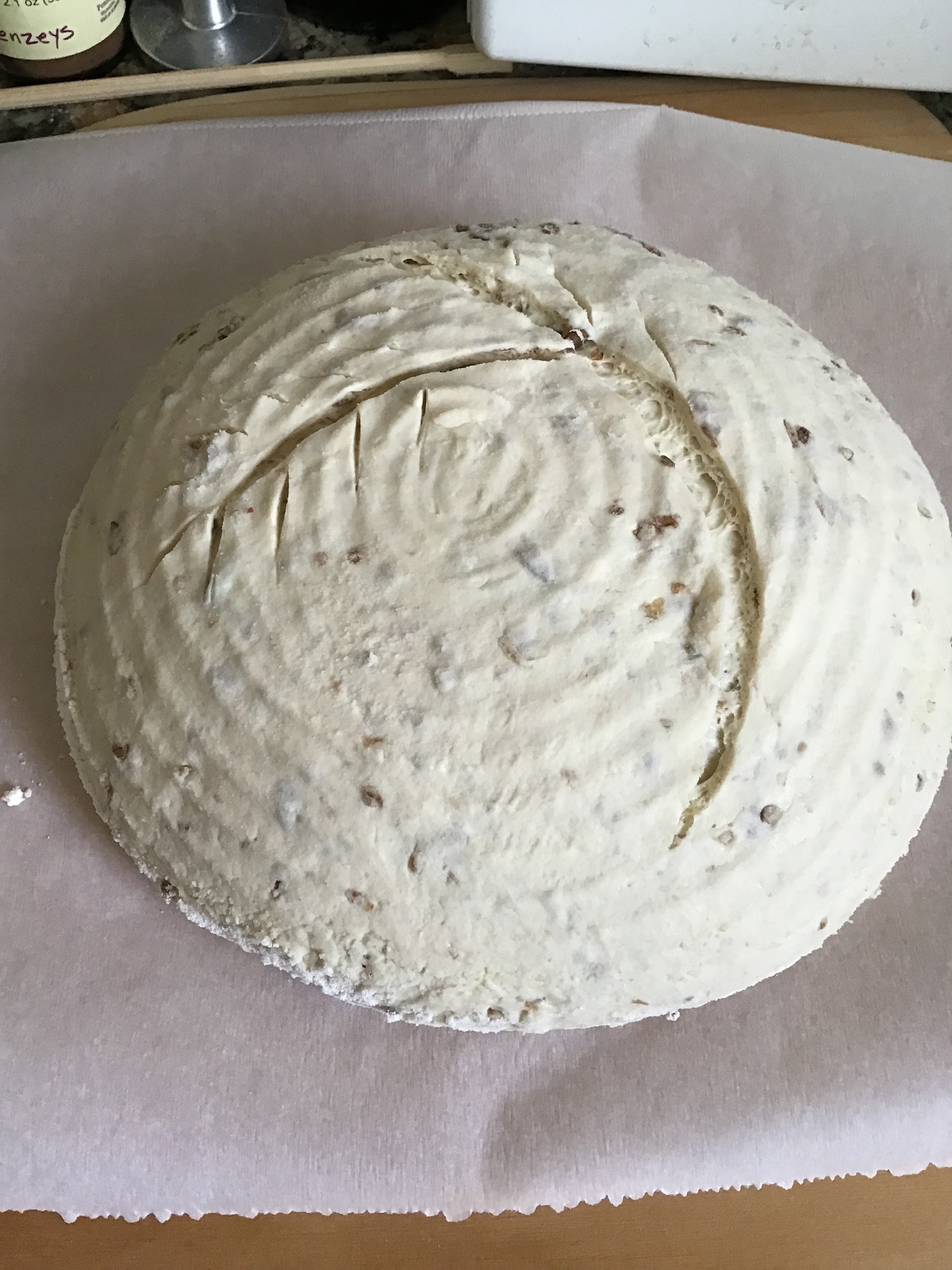
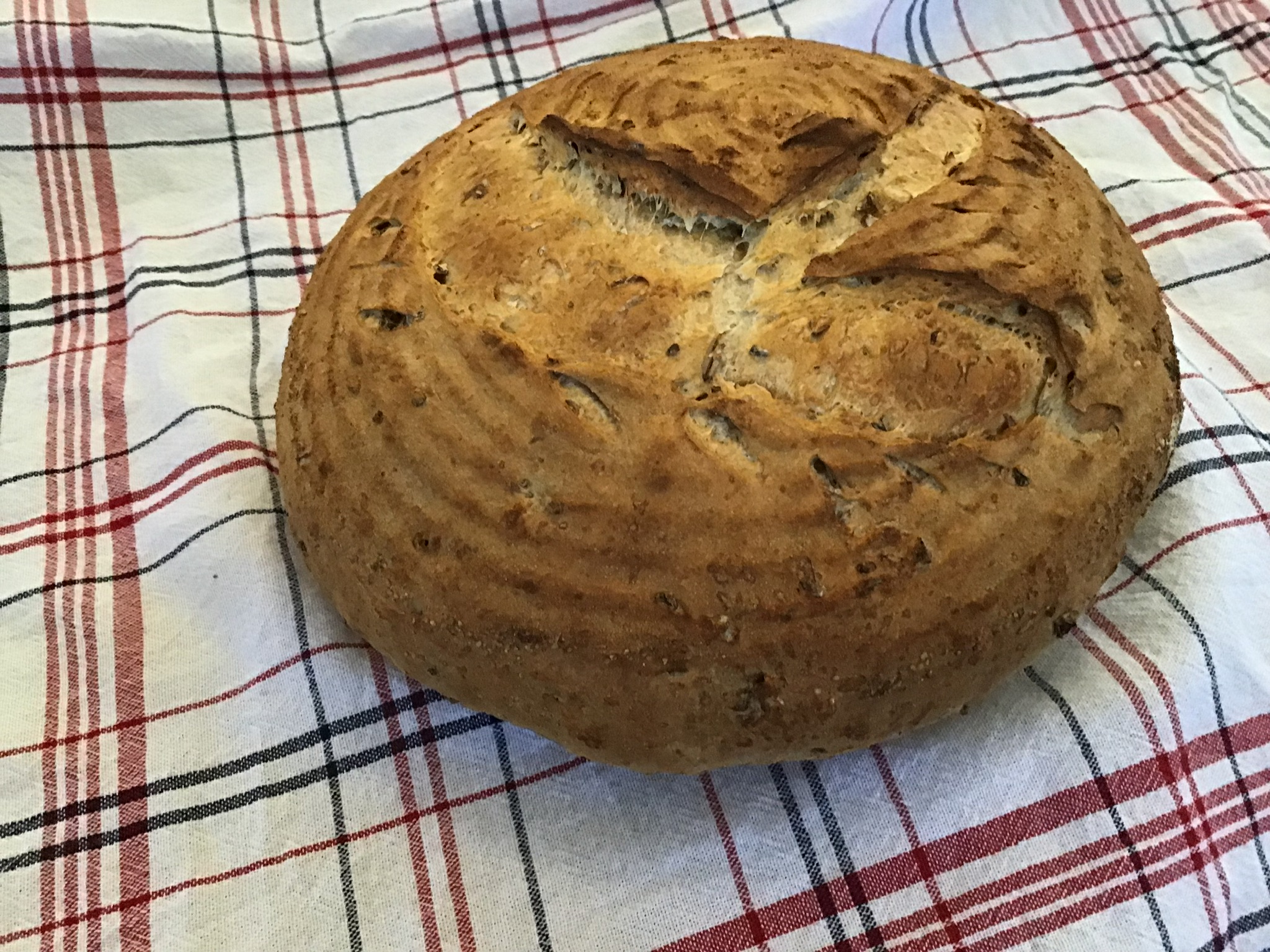
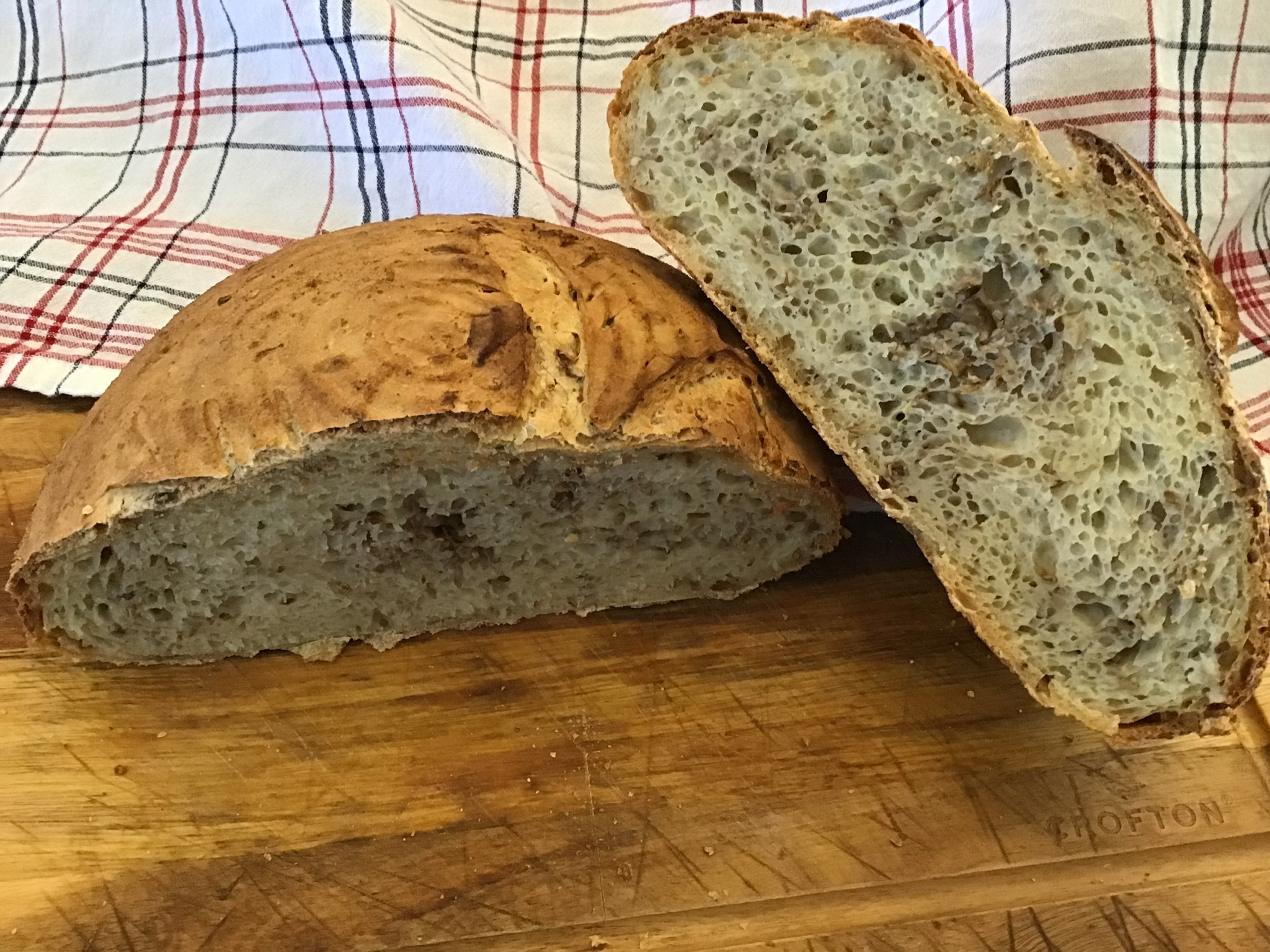
Last edited:
TandemTails
Well-Known Member
No blog post for this one. Just a standard sourdough with 10% whole wheat flour.
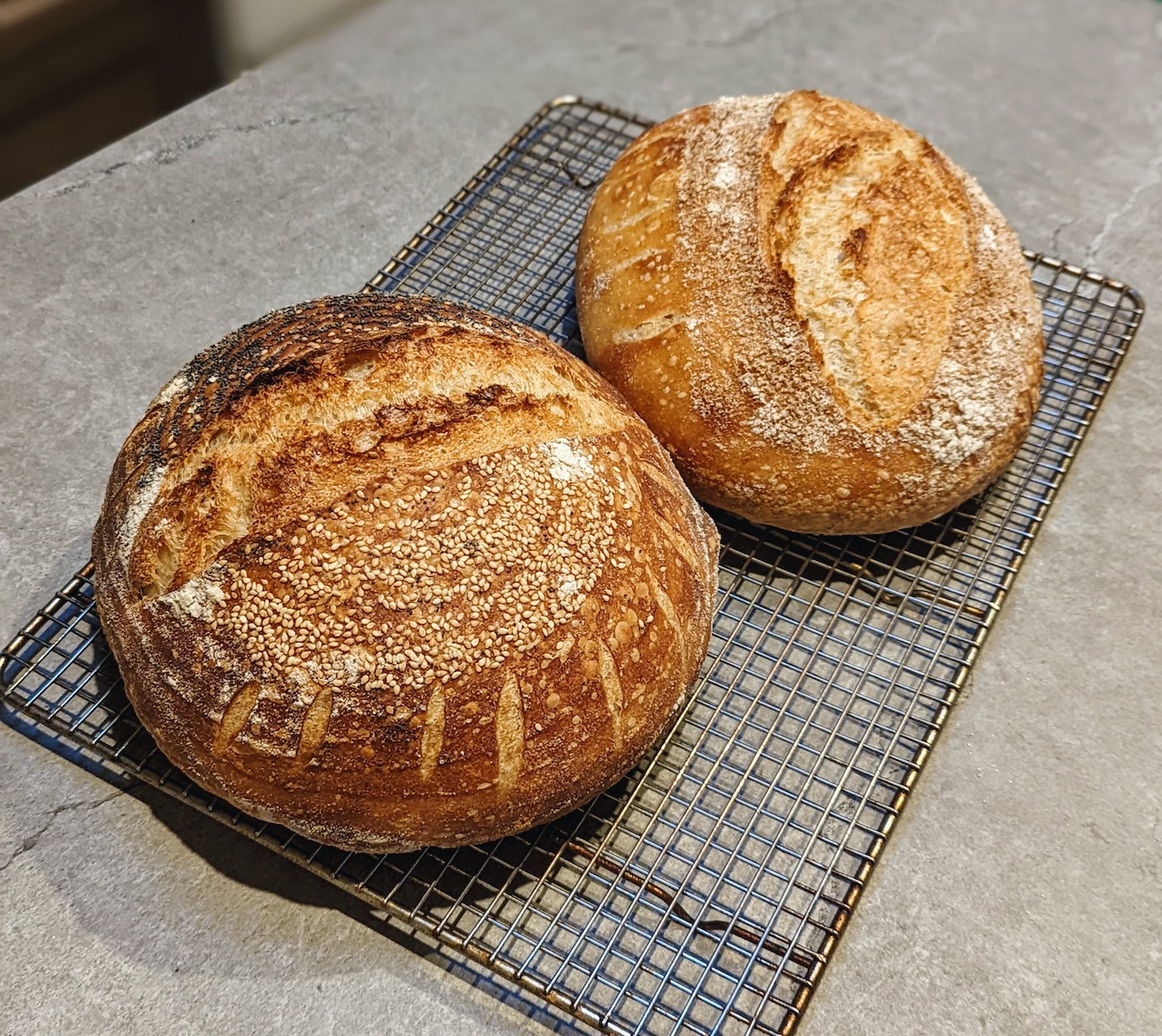
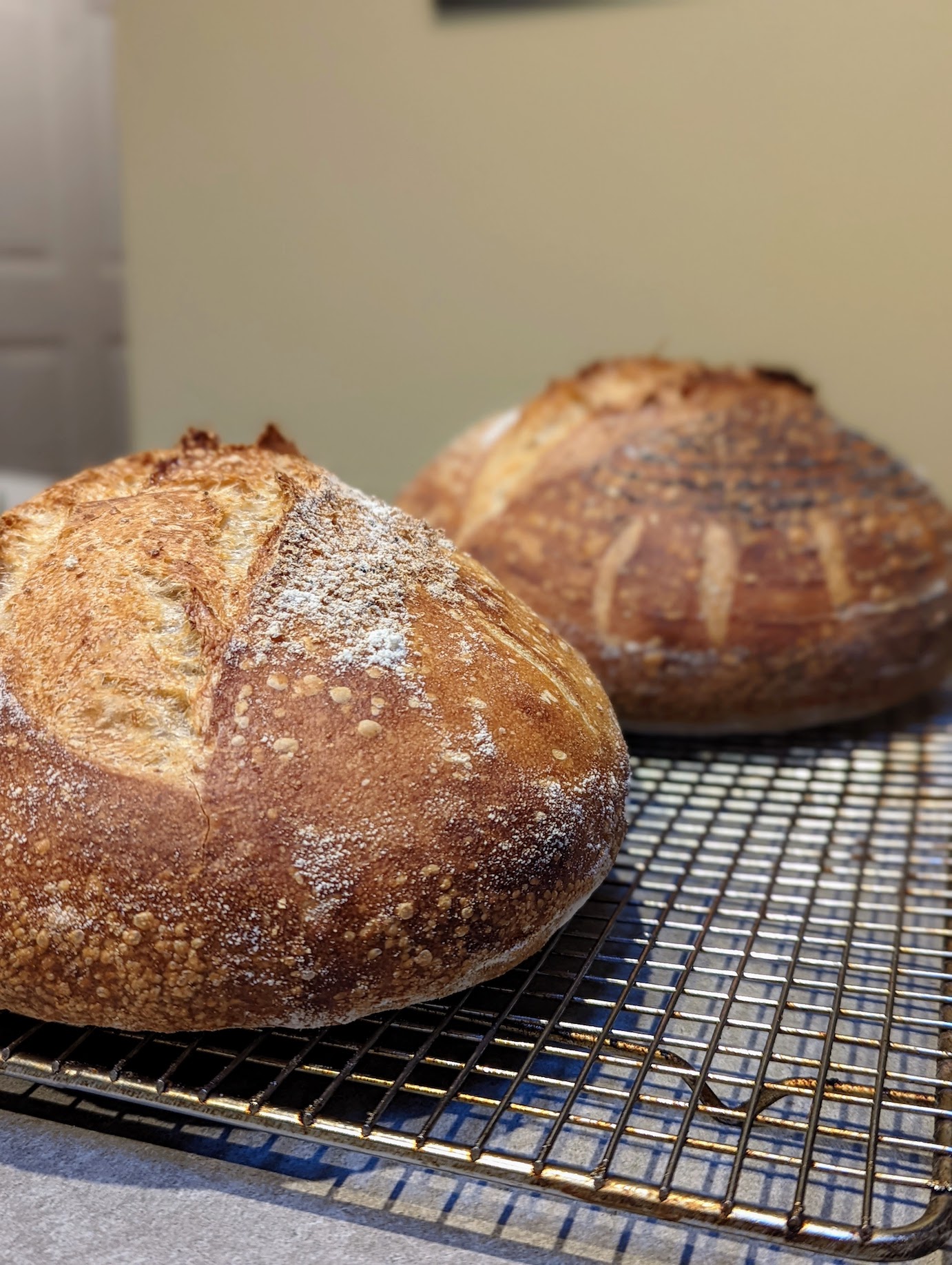
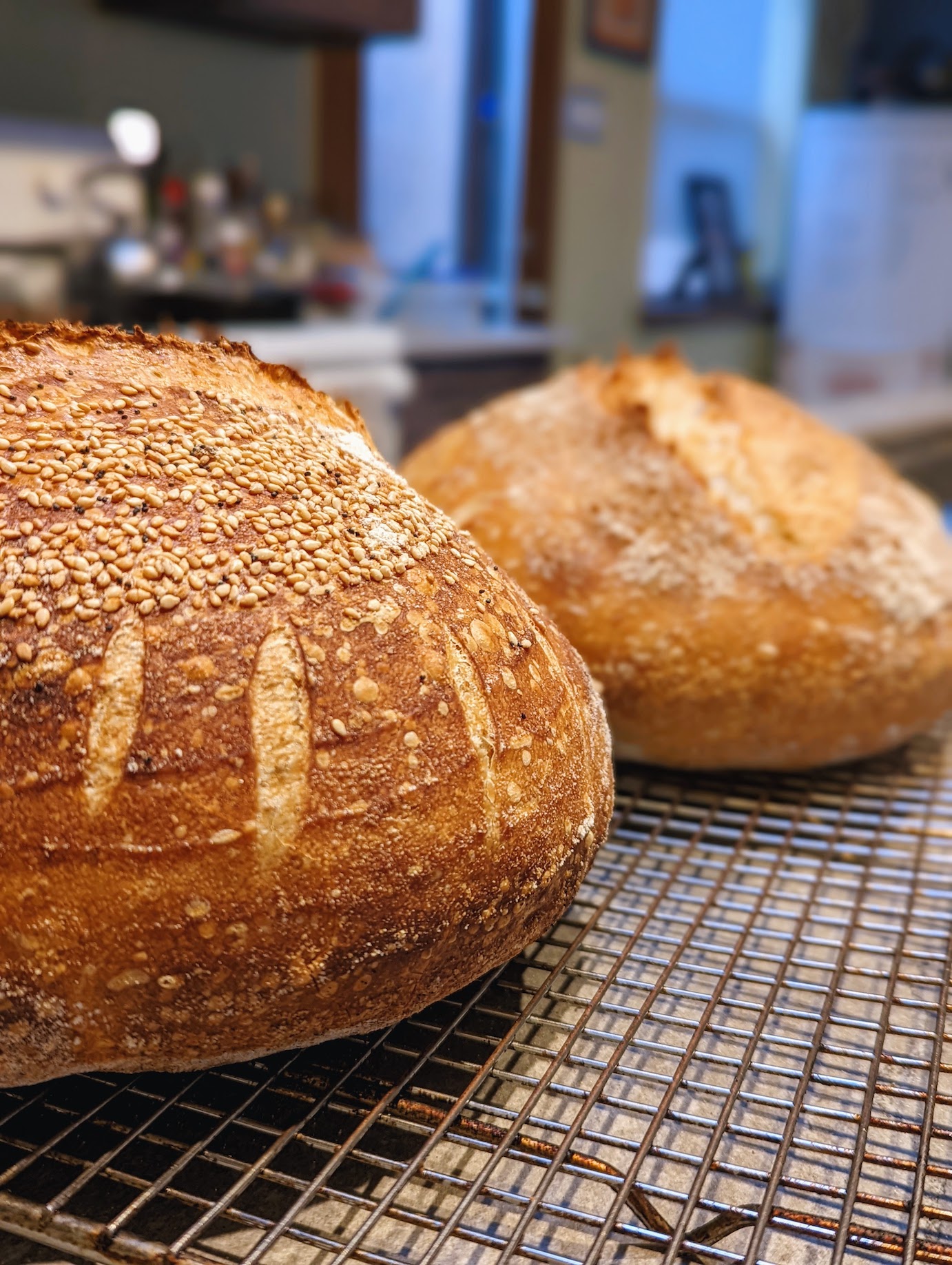





Anybody have a good, basic recipe for pumpernickel rye bread boules in a dutch oven? Recipes I'm finding online seem to be all over the road.
This seems good. Admittedly I’m not into pumpernickel unless it is “marble rye”. Sourdough Pumpernickel BreadAnybody have a good, basic recipe for pumpernickel rye bread boules in a dutch oven? Recipes I'm finding online seem to be all over the road.
Love marbled rye for pastrami sandwiches!
Make my first loaf from a starter that I started about a week and a half ago using a basic beginner recipe adapted from one Billy Parisi has published. Hydration seemed a little low to me (compared to all the pizza dough and the few yeast breads I have made), but I am happy with the result and just love the flavor of this first loaf!! Cooked this one in a preheated Dutch oven rather than on my steel. All I had was whole wheat and All Trumps, so that is what I used. I have some rye flour now too for the next attempt.
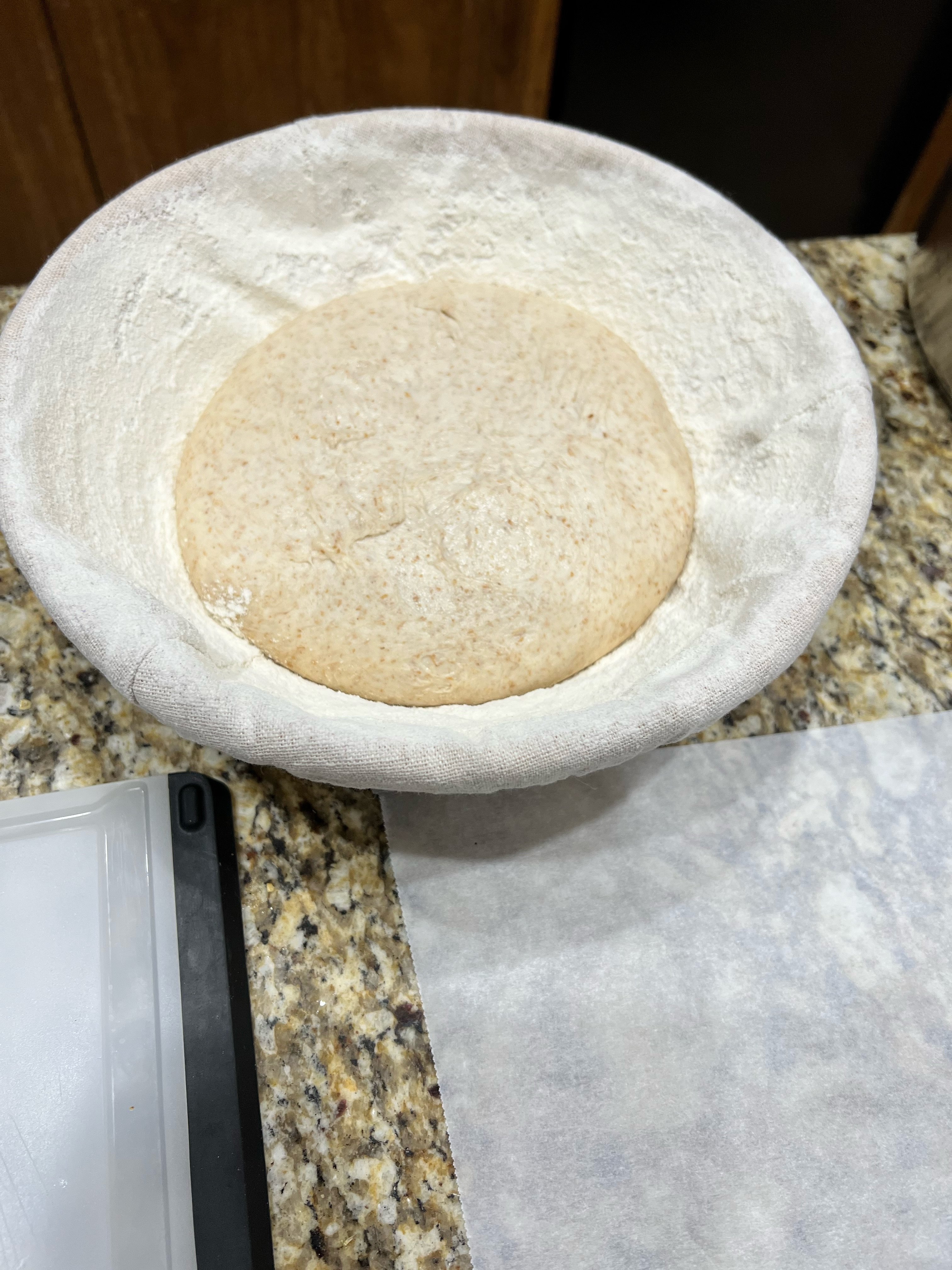

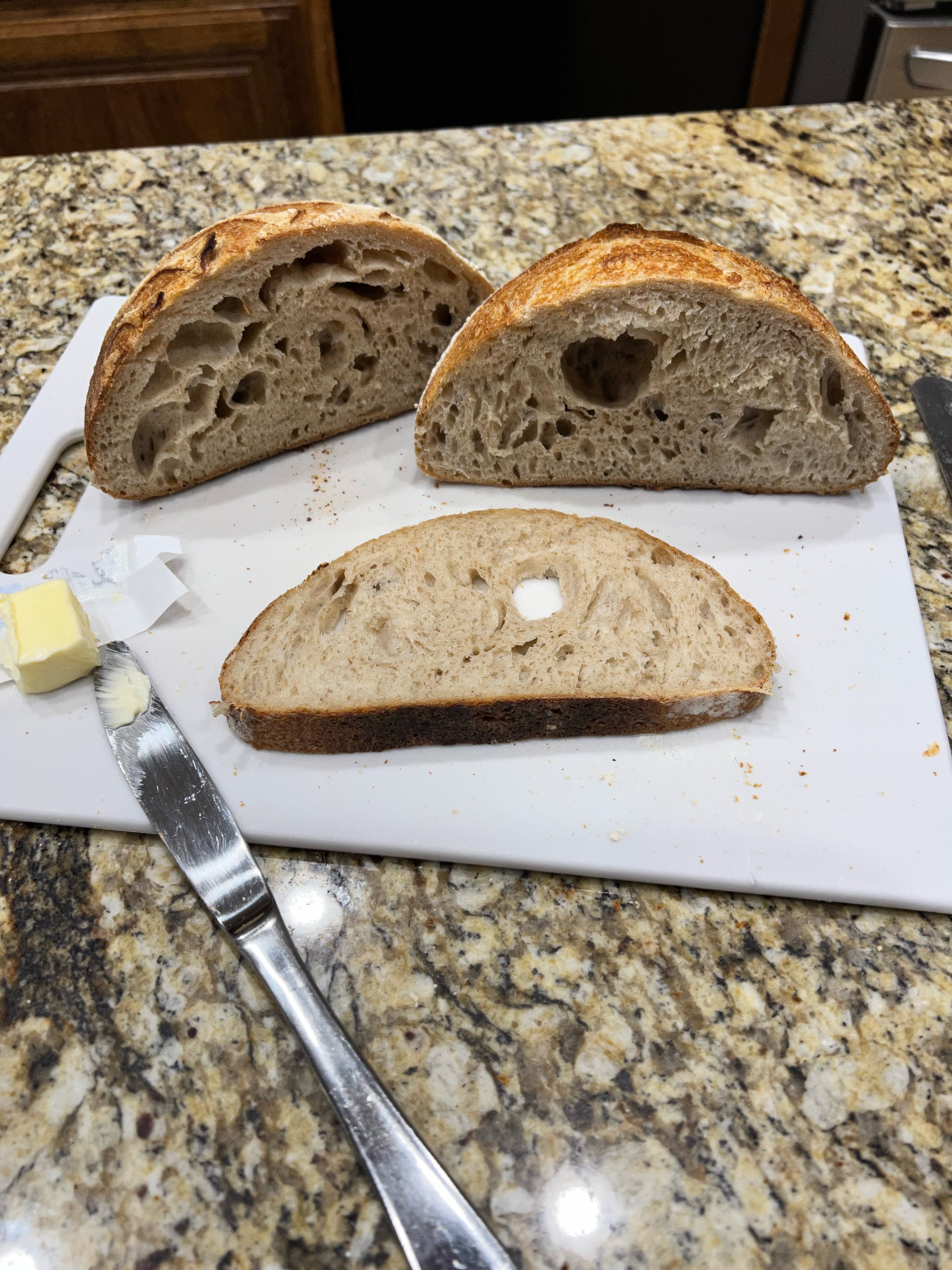
Make my first loaf from a starter that I started about a week and a half ago using a basic beginner recipe adapted from one Billy Parisi has published. Hydration seemed a little low to me (compared to all the pizza dough and the few yeast breads I have made), but I am happy with the result and just love the flavor of this first loaf!! Cooked this one in a preheated Dutch oven rather than on my steel. All I had was whole wheat and All Trumps, so that is what I used. I have some rye flour now too for the next attempt.



This just came out of the oven. It's almost half whole wheat with a little bit of rye flour. This one feels heavy and dense compared to my previous attempt. I'm expecting a much tighter crumb. I maybe did learn to make my decorative scores much shallower compared to my attempt above, but it could be the bread did not expand enough in the oven. I'll figure it out when it cools off enough.
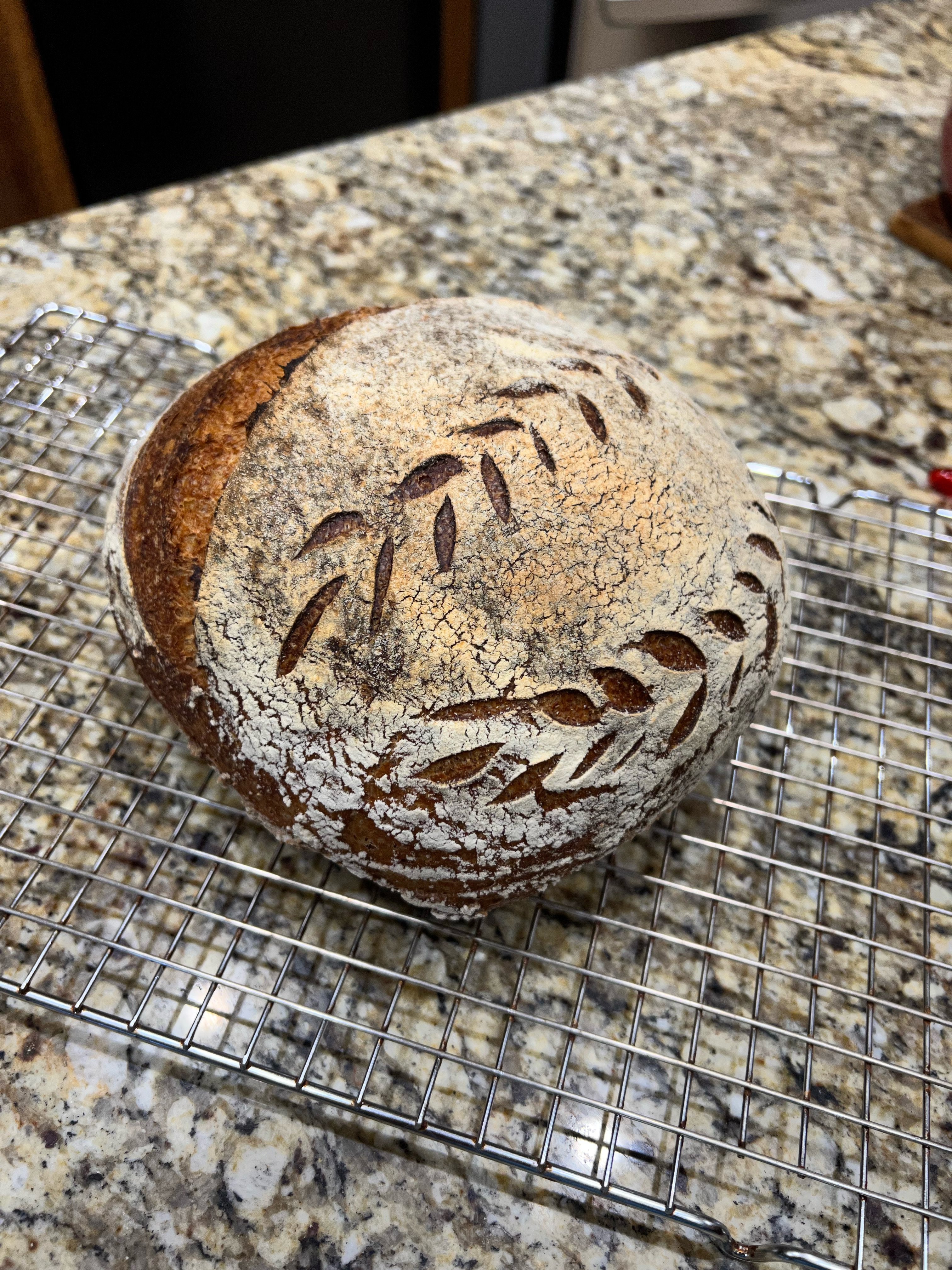

Denser as I thought, but still a pretty nice crumb I think. Very tasty with the extra whole wheat and rye!




TandemTails
Well-Known Member
Denser as I thought, but still a pretty nice crumb I think. Very tasty with the extra whole wheat and rye!
View attachment 759565View attachment 759566
with that much rye and whole wheat, I'm really impressed with how much rise you ended up getting!
Thanks. You probably know much more about it that I do. That loaf was a bit of a stretch because I did not really follow the recipe. The recipe wanted me to make a 100% hydration levain, basically, using a mix of bread flour and whole wheat flour. I blew that off, as I had a very active 100% hydration starter that I had fed a few hours earlier. So I just subbed in my active starter, then did an autolyse for 1 hours, then added the starter and then the salt. So basically, I just played like I knew what the hell I was doing and got lucky that it came out pretty well! It's different than my first loaf that had the big bubbles, but OMG it made really nice BLTs for dinner and I love the flavor. I am just kinda pumped that it seems that if I keep at it, I will be able to control variables enough to produce breads with different characteristics depending on what I want to do with them!with that much rye and whole wheat, I'm really impressed with how much rise you ended up getting!
Really, I am just happy my starter is healthy, worked, and tasted great!! lol
My third sourdough attempt. This is pretty much the same recipe as I used for the first loaf, but instead of doing a 30 minute autolyse and then adding the levain, I went ahead and put the levain in at the same time I started the autolyse, then added the salt and part of the water after the 30 minutes. A tighter crumb than the first, but more open and less dense than the second recipe. I'm really happy with the flavor of all three attempts, and really happy with the way the scoring worked on this one. I also left off all the extraneous flour and rice flour I had on the previous loaves.
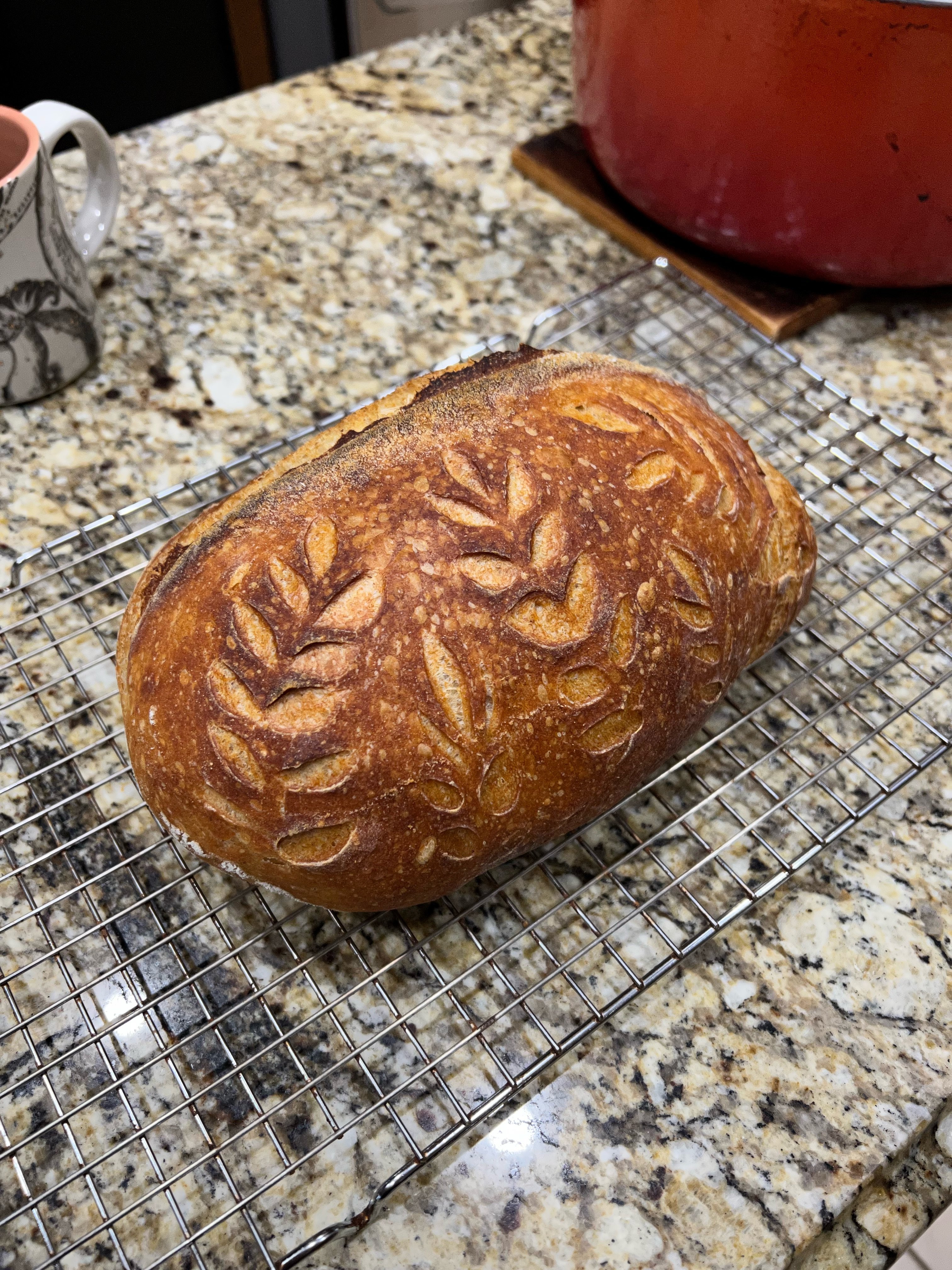

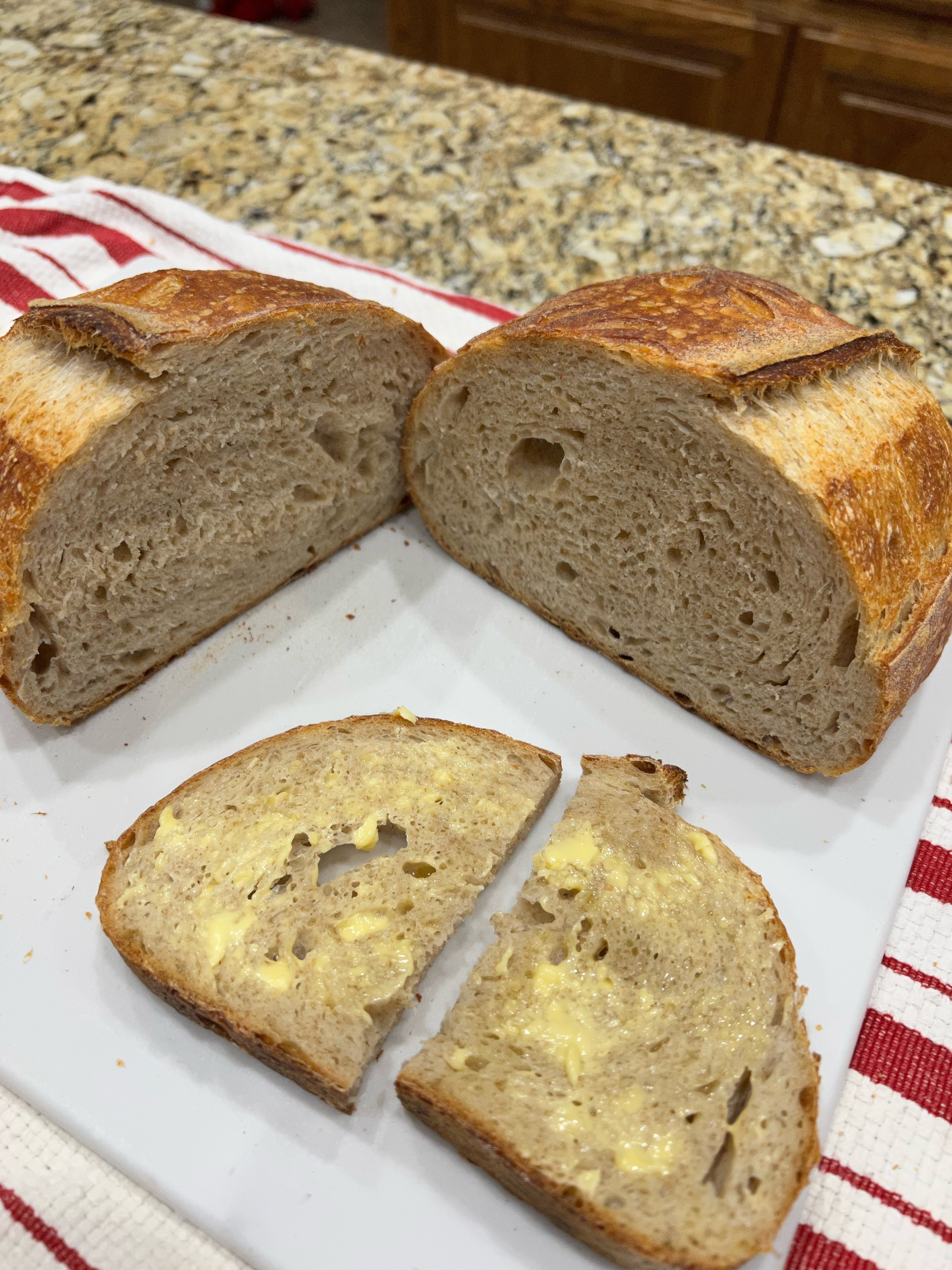



Forth sourdough loaf from a little over a week ago. This one was the same recipe as I did for the first.
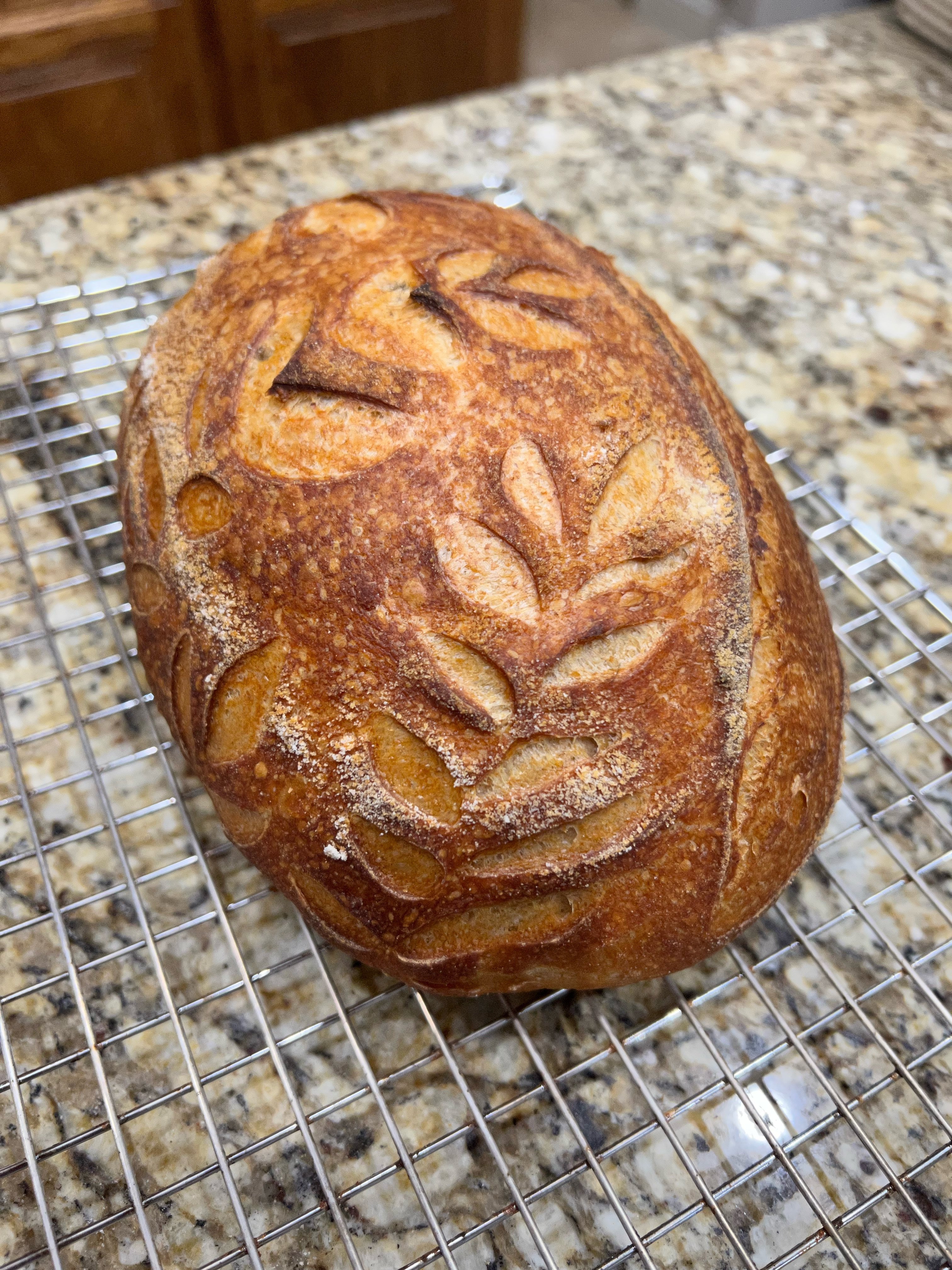
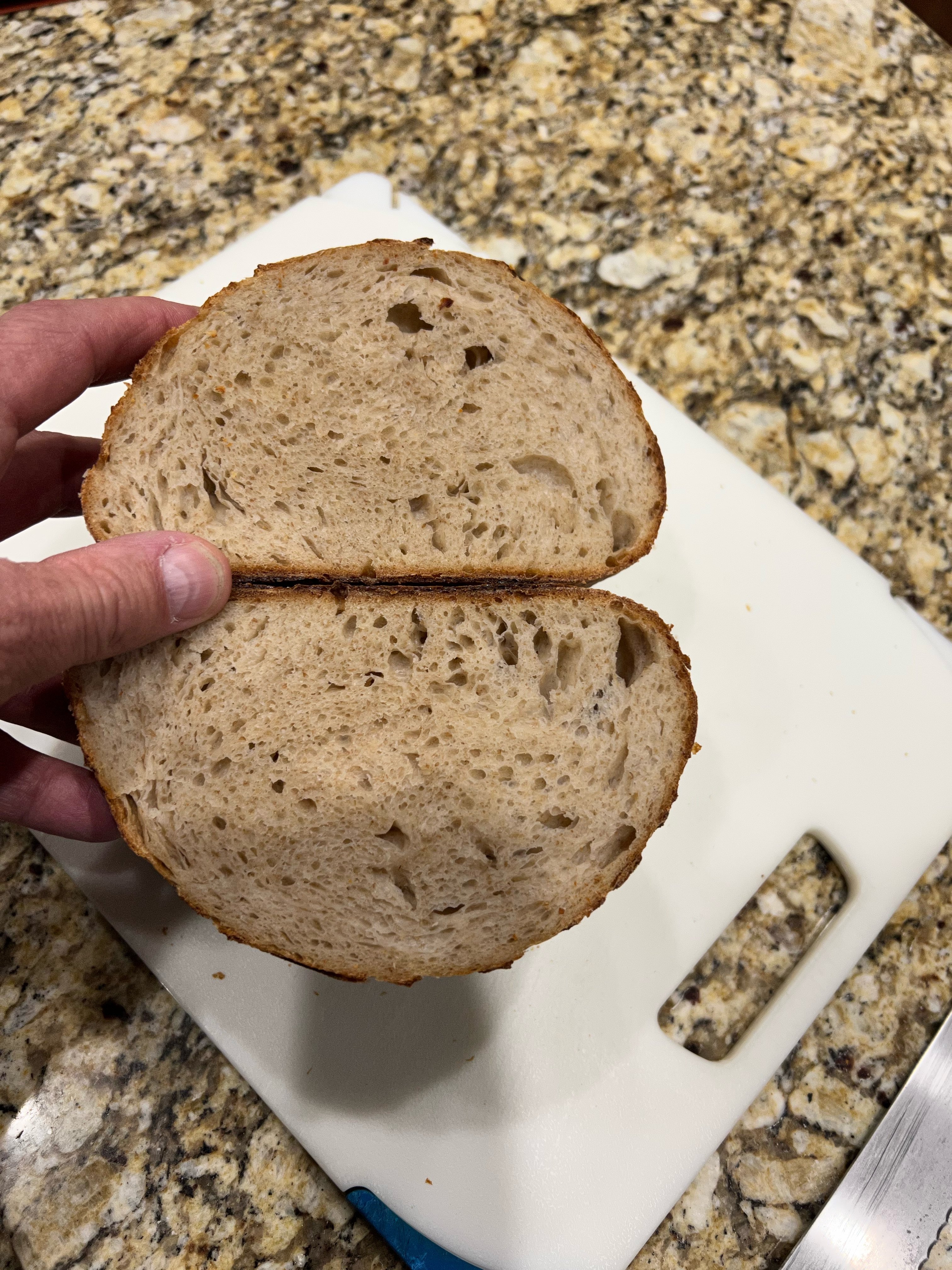
And my fifth attempt. This was a new recipe that I transcribed off of YouTube by Claire Saffitz. I was late getting started on this one on the day I made the dough and bulk ferm with hourly folds ran to about 10 PM and probably could have gone a little longer, but I needed sleep Baked it midday the next day so it only had about 14 hours or so cold ferment.
Baked it midday the next day so it only had about 14 hours or so cold ferment.
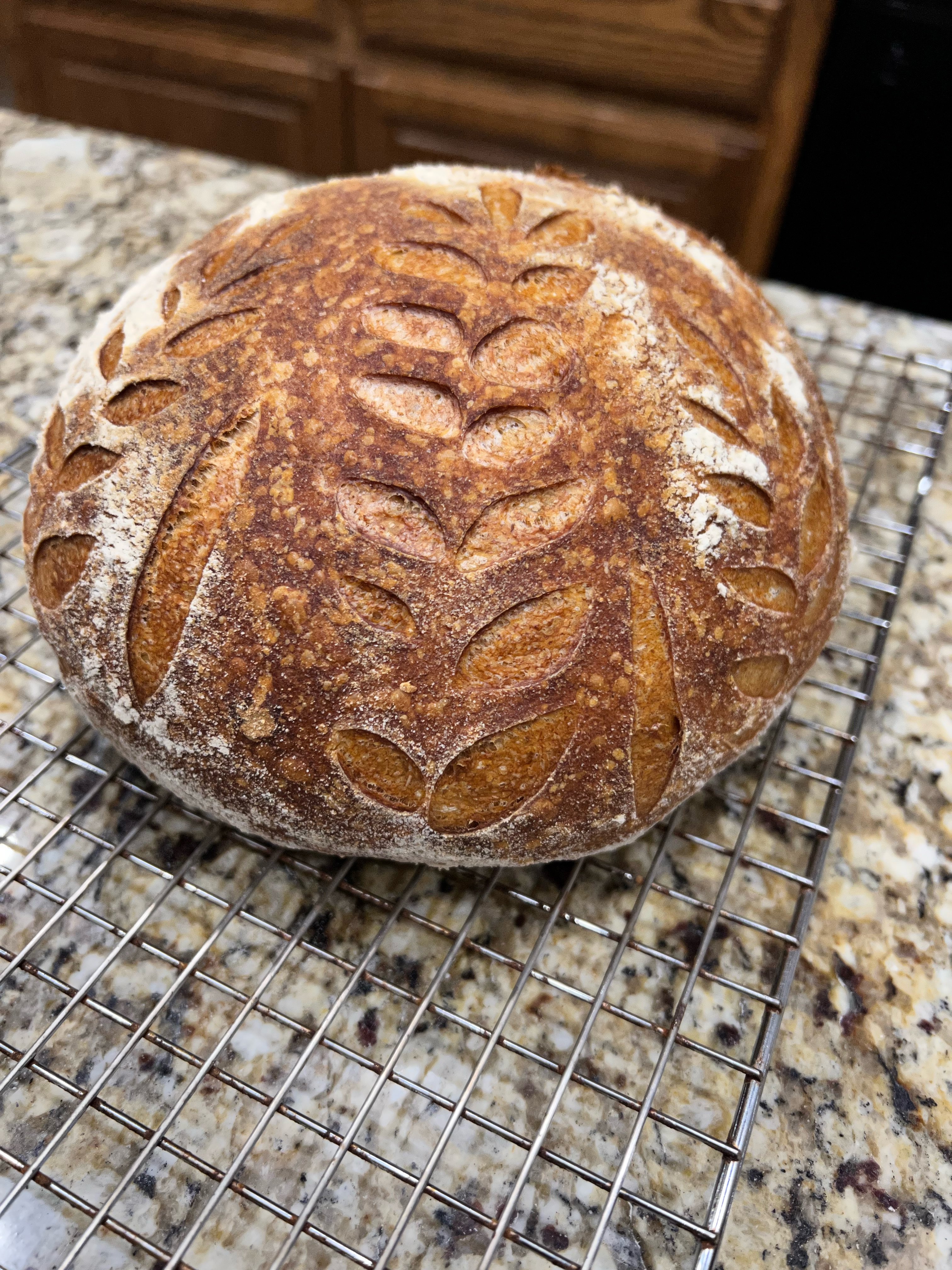
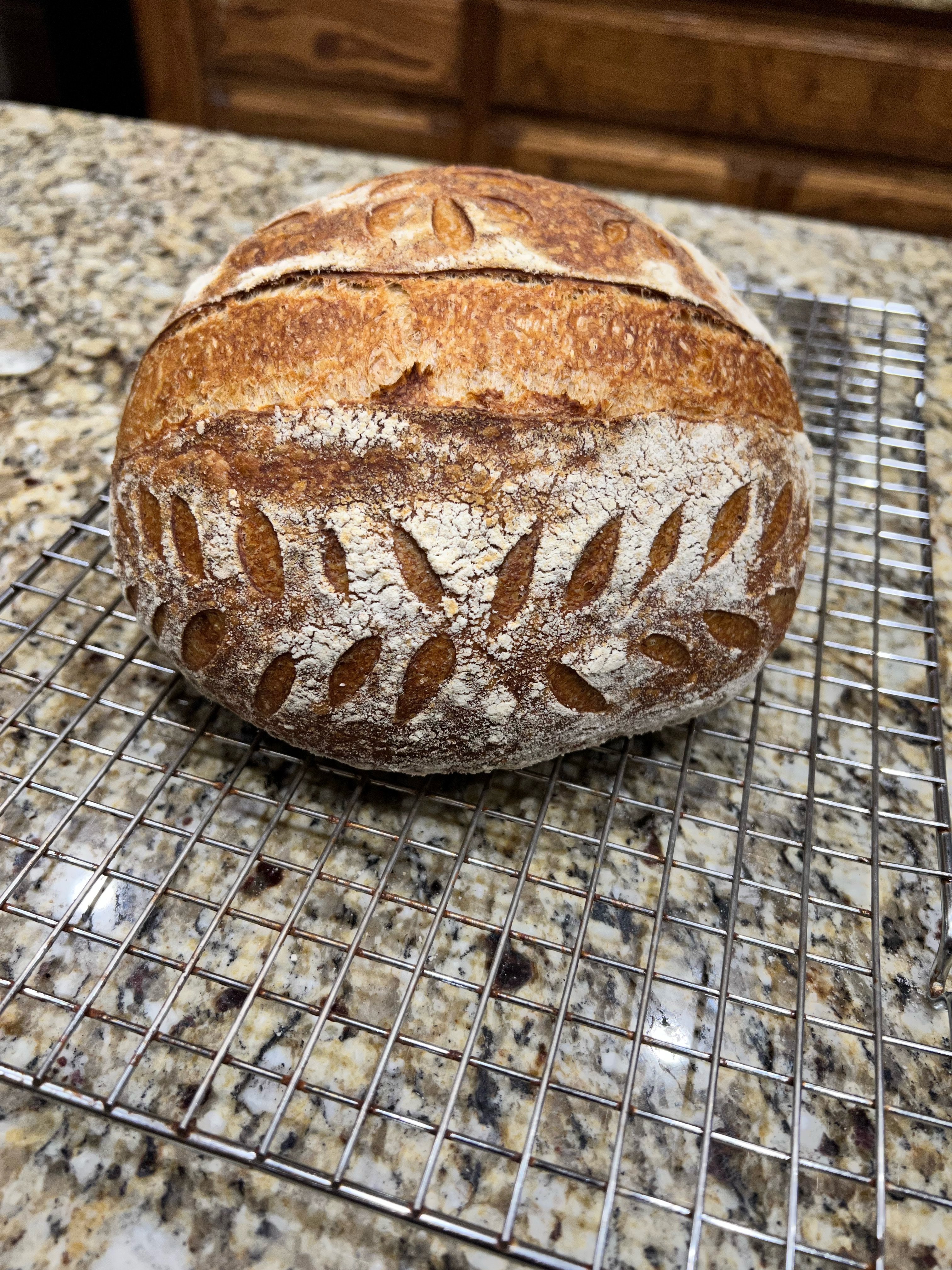
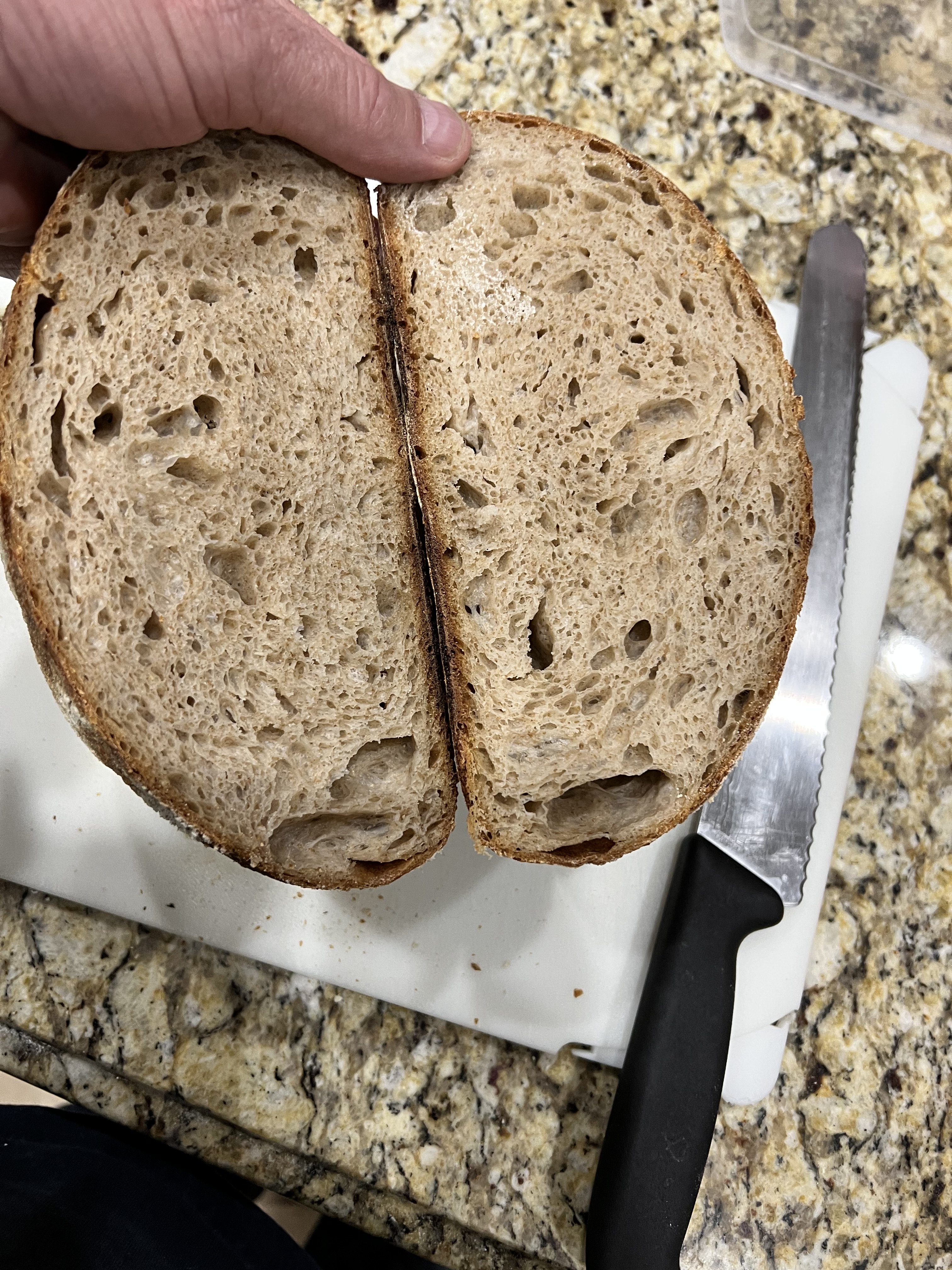


And my fifth attempt. This was a new recipe that I transcribed off of YouTube by Claire Saffitz. I was late getting started on this one on the day I made the dough and bulk ferm with hourly folds ran to about 10 PM and probably could have gone a little longer, but I needed sleep



GravesYardHB
New Member
That is a gorgeous looking loaf!I wanted a flavorful bread and definitely got it! This batch is loaded with roasted red bell peppers, smoked paprika and New Mexico red chile powder. I used the overnight schedule from FWSY and it came out really well.
Full recipe with method and more pics here: Overnight Loaves w/ Roasted Red Pepper, Paprika & Red Chile
View attachment 745766
View attachment 745767
View attachment 745768
View attachment 745769
DuncB
Well-Known Member
Yorkshire Pudding recipe for @bracconiere
Basic Batter
1 cup/ 125g/ 4oz of Plain Flour
Pinch of salt
1 egg
1 1/4 cup / 300ml / half pint milk
Into blender liquid first and blend until smooth.
Stand for one hour and ensure consistency of heavy cream ( it should still pour ).
Brush bun / muffin tin with beef dripping, butter or oil. For mini Yorkshires I use the mini muffin tins which are less than 2 inch across.
Place onto top shelf oven preheated to 220 Celsius / 425 F until the oil begins to smoke.
Remove pan and fill each "tin " about 2/3 full with batter
Bake 15 - 20 minutes until risen and golden, If making minis this time will be less.
Add toppings and eat warm.
Picture of my sourdough as it's the bread thread.
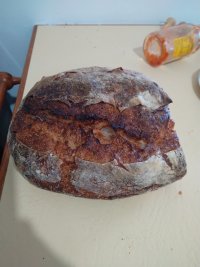


Basic Batter
1 cup/ 125g/ 4oz of Plain Flour
Pinch of salt
1 egg
1 1/4 cup / 300ml / half pint milk
Into blender liquid first and blend until smooth.
Stand for one hour and ensure consistency of heavy cream ( it should still pour ).
Brush bun / muffin tin with beef dripping, butter or oil. For mini Yorkshires I use the mini muffin tins which are less than 2 inch across.
Place onto top shelf oven preheated to 220 Celsius / 425 F until the oil begins to smoke.
Remove pan and fill each "tin " about 2/3 full with batter
Bake 15 - 20 minutes until risen and golden, If making minis this time will be less.
Add toppings and eat warm.
Picture of my sourdough as it's the bread thread.



Japanese milk bread dinner rolls
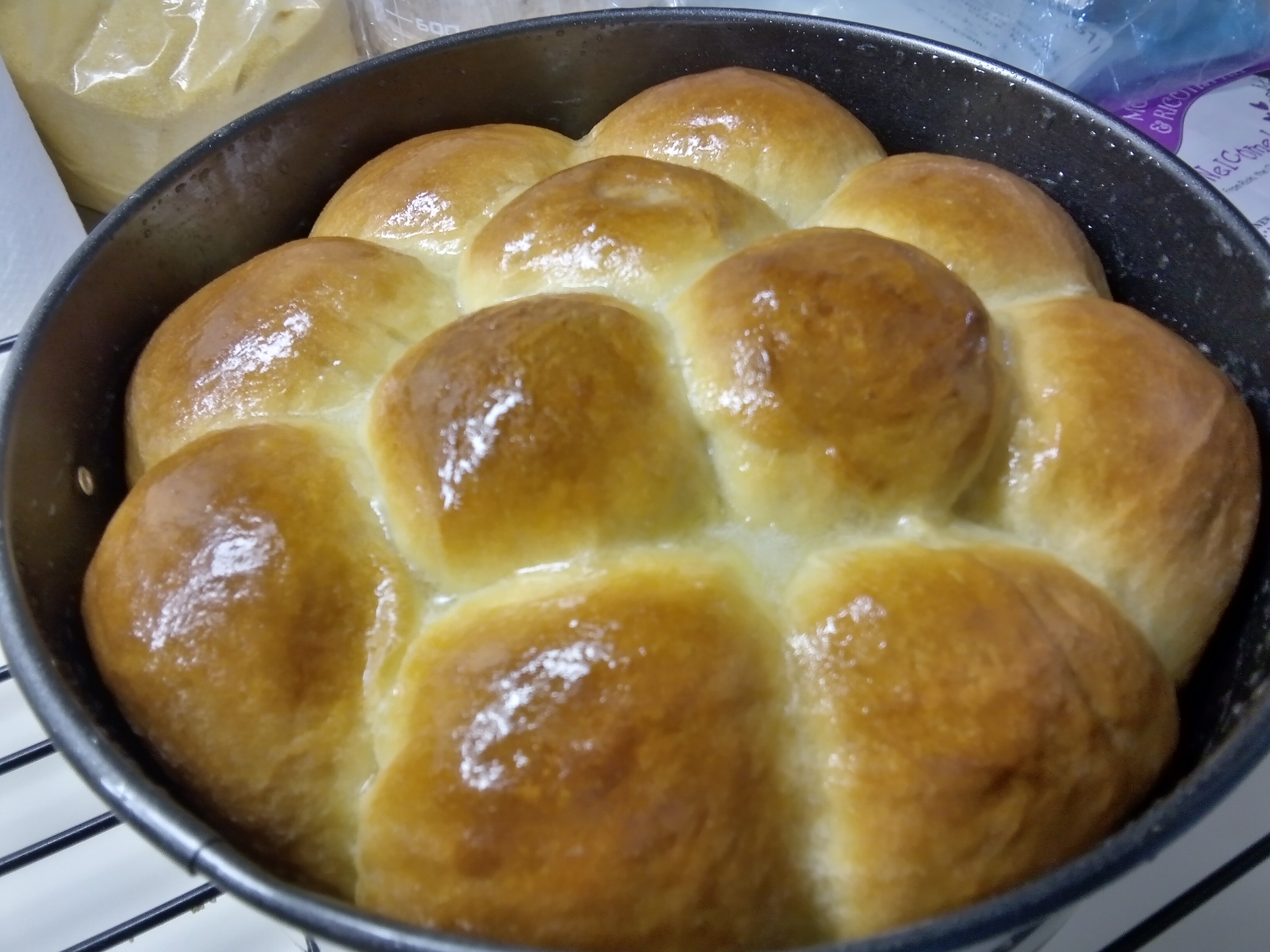

Similar threads
- Replies
- 7
- Views
- 1K
- Replies
- 4
- Views
- 1K





































